Intuitive operation | Rapid data transfer | Efficient control
HUMAN-MACHINE INTERFACE
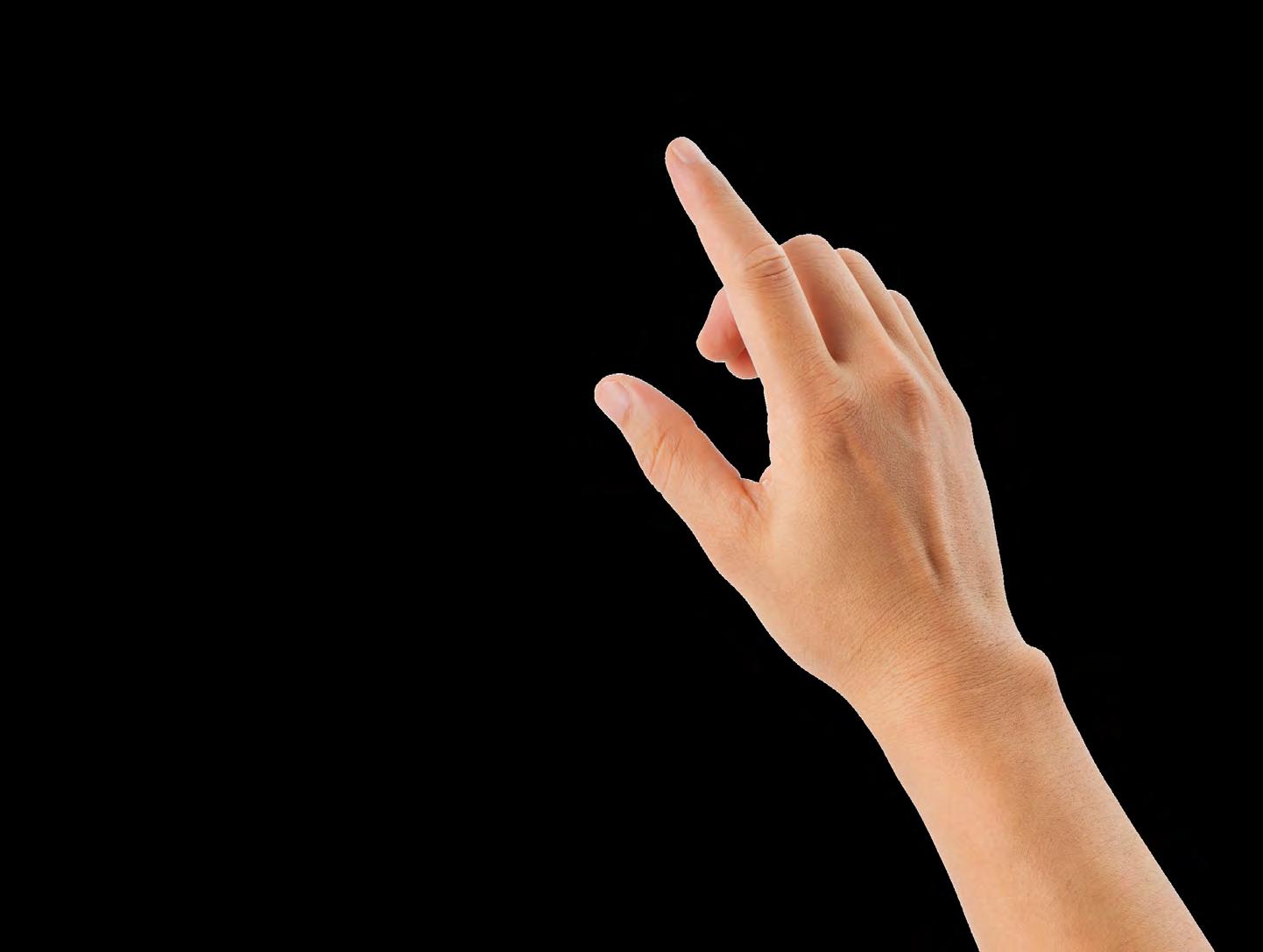
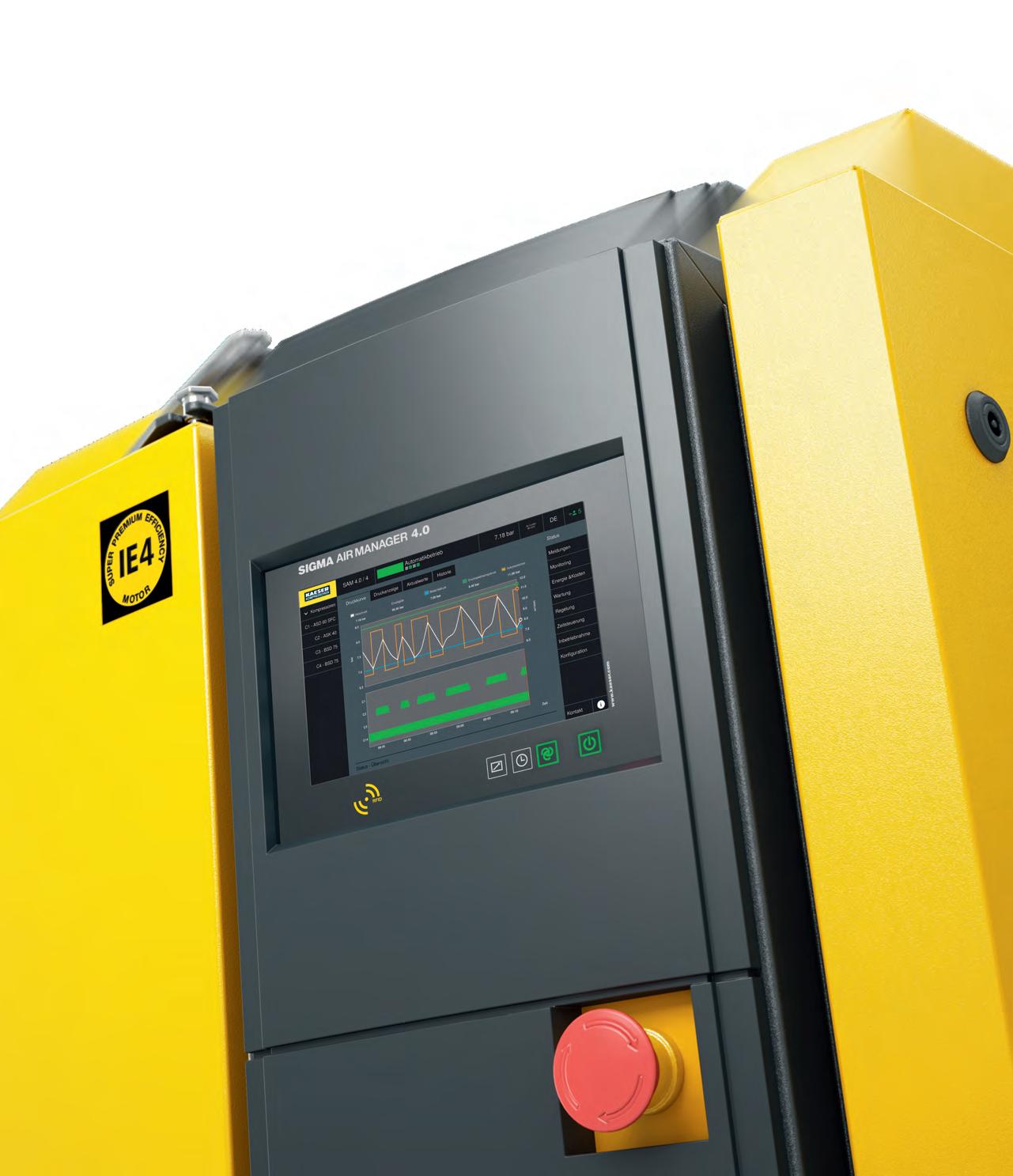
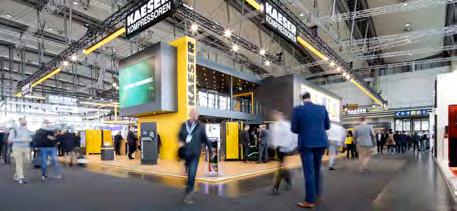

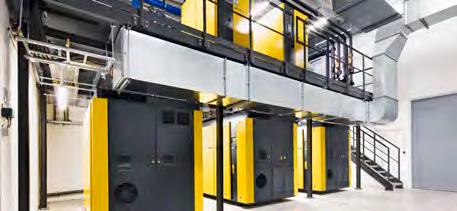

Published by: KAESER KOMPRESSOREN SE, 96450 Coburg, Germany, Carl-Kaeser-Str. 26 Tel. +49 (0)9561 640-0, Fax +49 (0)9561 640-130, www.kaeser.com, E-mail: productinfo@kaeser.com
Editorial office: Petra Gaudiello (Editor), E-mail: report@kaeser.com
Layout: Sabine Deinhar t, Theresa Götz, Katharina Lips
Photography: Marcel Hunger
Printed by: Schneider Printmedien GmbH, Weidhausen Changes of address/ subscription cancellations: customer.data@kaeser.com
The editorial office cannot accept liability for any unsolicited manuscripts and photographs. Reproduction, including excerpts, only with written authorisation.
USt-ldNr.: DE 132460321
Register of companies: Coburg, HRB 5382
Your personal data will be used and stored by us for marketing purposes. For detailed information, see www.kaeser.com/int-en/privacy-marketing.aspx.
refuse the
and storage of your data for marketing purposes at any time at: customer.data@kaeser.com.
Artificial intelligence: Hype or a sustainable necessity?
Artificial intelligence (AI) offers significant potential for value creation in the manufacturing sector. This applies not only to large businesses but equally to small and medium-sized enterprises (SMEs).
Studies suggest that AI will account for approximately one third of average future economic growth. Its ability to enhance quality and streamline processes spans the entire value chain. This includes cross-functional activities such as research and development, corporate planning, human resources, finance, tax, legal matters, and logistics, as well as core activities such as procurement, production, marketing and sales, and service and customer support. 1)
AI applications are already in wide use throughout every stage of the value chain. These include predictive analytics (e.g. monitoring and maintenance of production equipment), optimised resource management (e.g. improving production and manufacturing
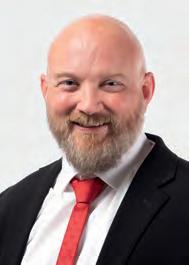
schedules), quality control (e.g. inspecting component properties), intelligent assistance systems (e.g. assembly instructions and support for manufacturing processes), knowledge management (e.g. data models for complex engineering processes), robotics (e.g. adaptive, learning robotic systems), autonomous driving (e.g. driverless transport systems), intelligent automation (e.g. automating routine production processes), and intelligent sensor technology (e.g. pre-processing data for monitoring of production equipment).
AI applications have the power to revolutionise every stage of the value chain, driving process quality, efficiency, and competitiveness to new heights. AI will therefore accompany us in all areas over the coming decades, so now is the time for every business to unlock this optimisation potential to achieve long-term, sustainable success.
Whether in automation, pneumatics, or eco-friendly systems, the factory of the future relies heavily on advanced compressed air and vacuum technology. For those striving to create energy-efficient and sustainable production processes, this versatile, cross-industry technology is indispensable.
The HANNOVER MESSE unites the key sectors of industry under one roof, attracting visitors interested in exploring the latest innovations and trends, sharing knowledge, networking, and forging new business relationships.
Leading global companies present cutting-edge technologies and offer practical solutions to the pressing challenges of modern industry. Visitors can learn about the groundbreaking advancements in production and energy supply that are driving progress across various sectors. In 2025, Hanover will once again provide the stage for technological innovation, cross-sector collaboration, and networked industrial ecosystems.
Key priority: Energy efficiency
Energy efficiency has long been a key priority for businesses and industries, even before the energy crisis. At the KAESER exhibition stand in Hall 12, Stand B14, visitors can experience at first hand how the Coburg-based systems provider effectively addresses the ever-present challenge of energy savings and efficiency with its innovative products and services. True to its motto of “More compressed air for less energy,” KAESER KOMPRESSOREN is dedicated to delivering solutions that meet and exceed these critical demands.
In many businesses, compressed air generation holds untapped potential for significant savings. By leveraging this oppor tunity, companies can not only reduce their environmental footprint but also achieve considerable cost advantages. KAESER’s comprehensive portfolio is designed to achieve these goals, tailored to meet the unique needs of each situation. From innovative concepts and advanced technologies to high-performance individual products, KAESER delivers solutions that maximise efficiency when integrated into optimised compressed air systems.
Energy savings through heat recovery
Heat recovery involves capturing the exhaust heat produced during compressed air generation and repurposing it for other applications. Remarkably, up to 96% of the electrical energy supplied to a compressor can be recovered as heat. This makes heat recovery an exceptionally efficient solution for saving energy and reducing operating costs.
Businesses can utilise heat recovery in various ways. For example, the warm cooling air generated by a compressor can be used to heat production facilities, workshops, or office spaces, significantly reducing heating costs, especially in energy-intensive industrial settings. Another common application is heating process or utility
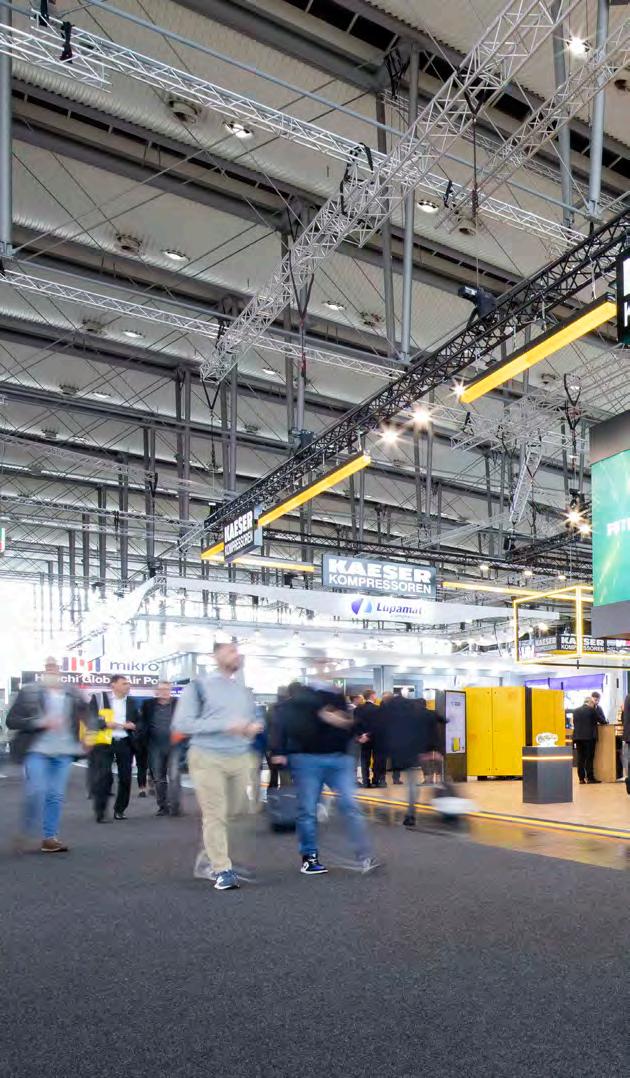
Shaping the future
water. Many industrial processes require heat for tasks such as drying, material heating, or hot water applications. With an integrated heat exchanger, KAESER compressors efficiently redirect exhaust heat to support these processes. Additionally, recovered heat can be used to warm water for cleaning, showers, or other operational needs. A particularly innovative approach is the “heatto-cool” principle, which uses the hot water from heat recovery to generate chilled water for climate control of buildings or production halls.
System-wide energy efficiency
Whether optimising existing systems or designing customised solutions from scratch, KAESER KOMPRESSOREN provides unparalleled consulting expertise. Utilising proprietary analysis methods compliant with ISO 11011 and drawing on a deep understanding of diverse industry requirements, KAESER develops future-ready solutions that prioritise energy savings.
“The first step toward optimising a compressed air supply is analysing the current situation,” explains Florian Dietz, Product Manager for Digital Products at KAESER KOMPRESSOREN. “Using our
future with TECHNOLOGY
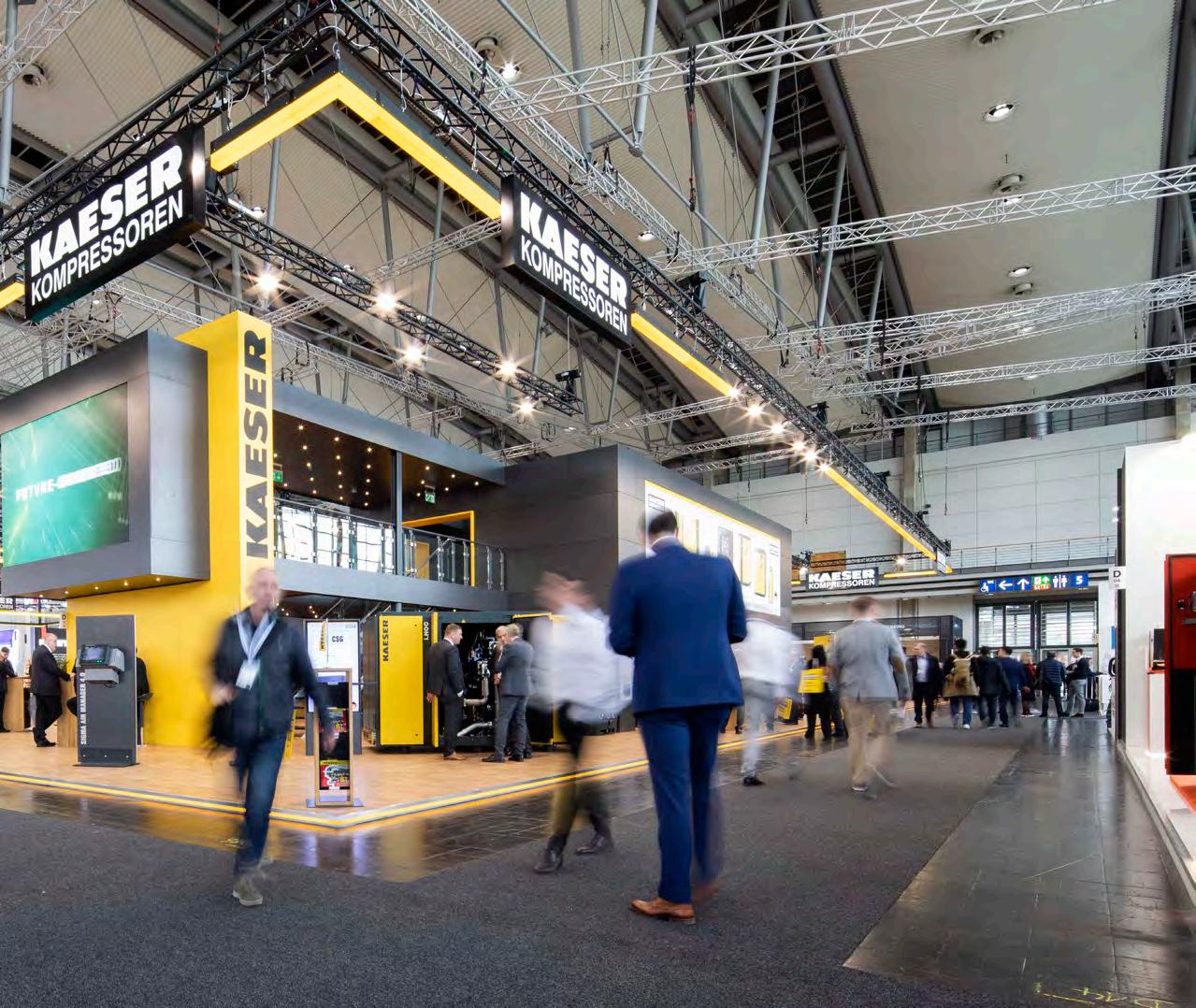
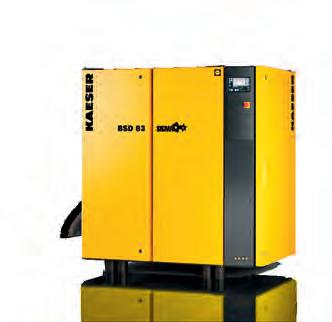


“Energy savings through heat recovery” is a key topic at the KAESER exhibition stand
ADA 4.0 analysis method, we collect and evaluate data from the existing compressed air station, focusing on air consumption, the station’s condition, and its operation. This approach enables us to provide reliable insights into energy efficiency, operational safety, and optimisation opportunities.” During the ADA measurement process, multiple sensors are installed in the compressed air station, and the usual KAESER quality applies here too. Expertly executed data collection forms the perfect foundation for meaningful analyses.
“The results from ADA 4.0 serve as a benchmark for designing, simulating, and evaluating potential improvements,” Dietz continues. “With KESS 4.0 – the KAESER Energy Saving System – we simulate alternative scenarios and evaluate potential savings. This allows us to determine the most energy-efficient combination of components and settings, perfectly tailored to
the user’s specific compressed air requirements.”
There’s so much to see and experience up close! We look forward to welcoming you to the KAESER exhibition stand at Hanover.
International trade fair for construction machinery, building material machines, mining machines, construction vehicles and construction equipment
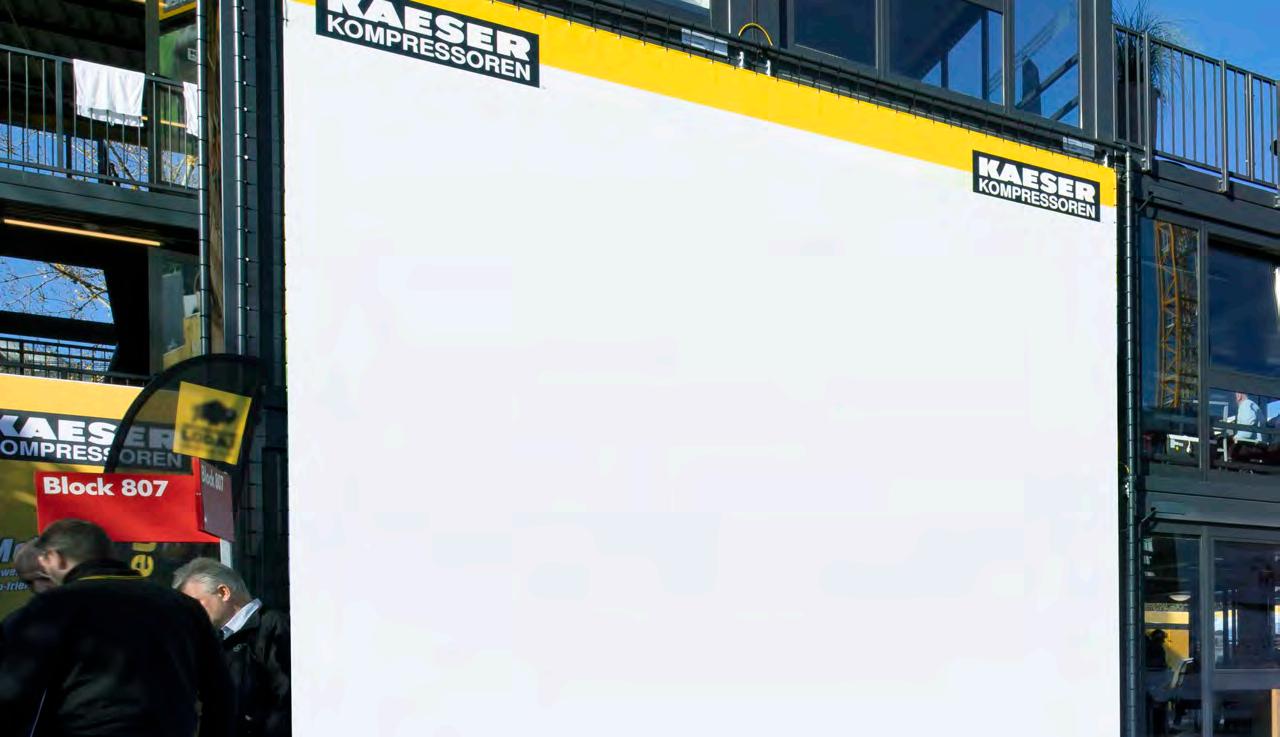
the Munich
The world’s premier trade
a wide
climate
fair
for
construction machinery returns to
exhibition centre from the 7th to the 13th of April 2025. With
2025
range of innovative solutions on show, key themes will include
neutrality, connected and sustainable construction, and alternative drive technologies.
Digitalisation and sustainability are the driving forces shaping the future of the construction industry, as reflected in the five core themes of bauma 2025.These themes will be brought to life through bauma’s extensive supporting programme and the groundbreaking innovations being showcased by exhibitors. The ideas and inspiration sparked here are set to have a significant impact on global markets. Nowhere else in the world will you find such a concentration of international industry leaders, cutting-edge solutions, and vibrant professional exchange.
KAESER KOMPRESSOREN is once again ready to make a bold impression at the world’s largest construction machinery trade fair, which this year occupies a record area of approximately 614,000 square metres. The striking compressor tower, featuring M27 compressors with various PE enclosure colours, will lead visitors to the KAESER exhibition stands (Outdoor Area FM708/11, FM708/09, FM808/5), where the Coburg-based compressed air systems provider will unveil a host of exciting innovations.
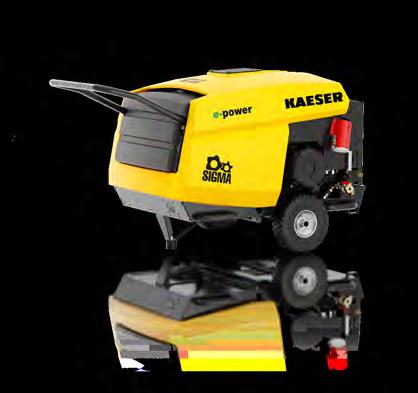
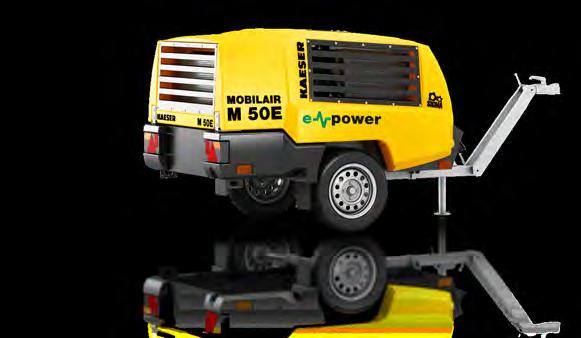
M10E
This compact por table compressor operates efficiently with either an external battery storage unit or a 400V socket equipped with a standard 16A fuse. It is ideal for applications such as dry ice blasting or installing fibre-optic cables.
New: M50E SFC
Building on the success of our proven M50E with durable star-delta starting, we are excited to introduce our latest solution featuring a frequency converter. This advanced model impresses with its low starting current and energy-efficient per formance, par ticularly in par tial load conditions.
Concept study: M50B
This new study offers a glimpse into what a battery-powered portable compressor in the 5m³ class could look like. It serves as a platform to explore and evaluate requirements for future developments.
M250E & M255E
The largest models in the MOBILAIR e-power series, with motor outputs of up to 160 kW, are already well known. Now, the introduction of Industry Mode takes them a step further, by extending maintenance intervals when used in clean industrial environments rather than on construction sites. This innovative feature enhances cost efficiency, making the units even more versatile for a wide range of applications.
New: M44PE with generator
The M44PE was launched in the autumn to bridge the gap between the M30 and M59 European models. At bauma, we are excited to introduce the M44PE with a generator option, meaning that this compact compressor is not only capable of delivering quality compressed air, but is also able to provide up to 13 kVA of electrical power.
Where to find us:
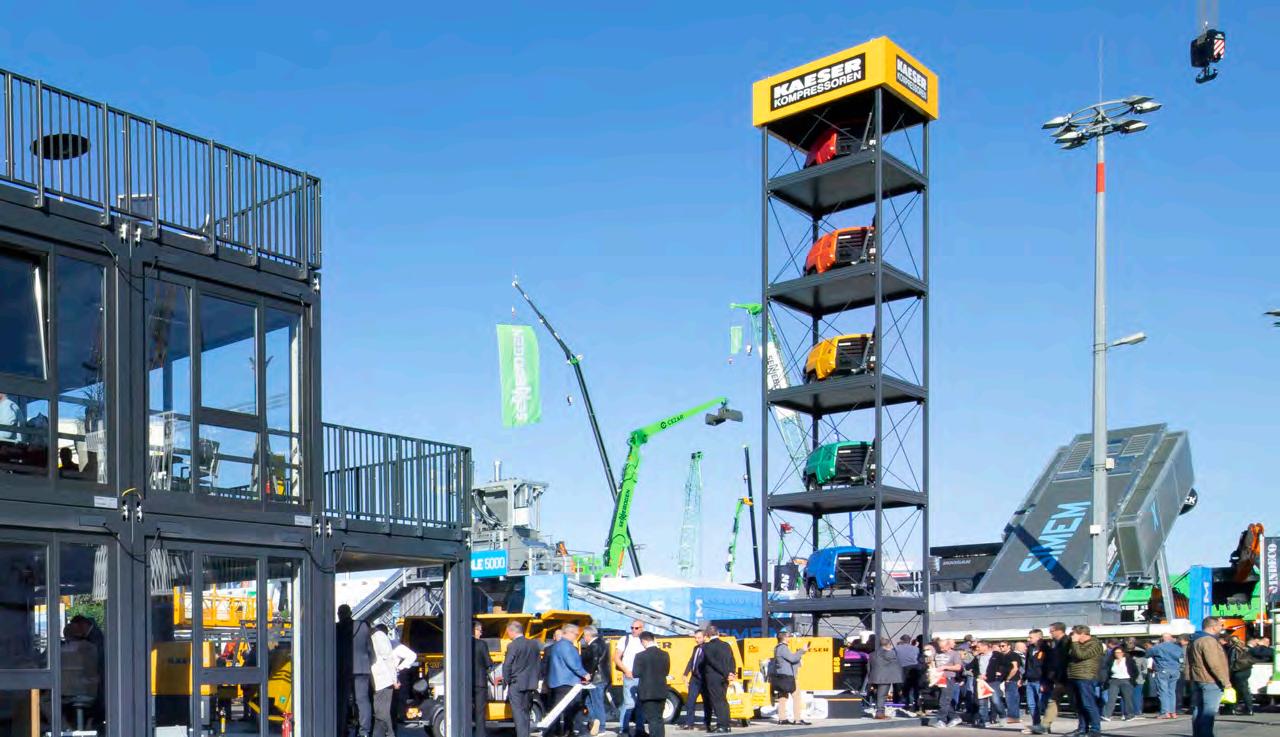
New: M76 & M81
Munich, Outdoor Exhibition Area central FM708/11, FM708/09, FM808/5
East entrance
The latest additions to the 8m³-class portable compressor range will also make their debut at bauma. The M76 is equipped with a Kubota engine, while the M81 features a Hatz engine. Both models of fer exceptional flexibility with a pressure range from 6 to 14 bar, thanks to Kaeser’s innovative pV Control. They also stand out for their maintenance-friendly design and an extensive selection of equipment options, including a generator and various compressed air treatment components.
M480
Our latest and most powerful oil-injected MOBILAIR compressor is specifically tailored for the North American market. Powered by a Tier 4-compliant Cummins engine, it delivers an impressive flow rate of up to 48 m³/min. Featuring pV Control, the M480 offers versatile pressure adjustment within a range of 6 to 14 bar. We are proud to be showcasing the road-mobile version of this powerhouse at bauma. For added versatility, the M480 is available with an auxiliary chassis and parking brake or as a stationary skid-mounted version.
M500-2 with i.DC-R 450 desiccant dryer
The portable, dry-running M500-2 has always been a highlight at bauma, particularly when it’s in operation. This year, we’re taking it a step further by demonstrating not only the compressor but also a durable, outdoor-ready compressed air treatment system. This system reliably achieves a pressure dew point of -40 °C, even under the harsh environmental conditions found in desert regions.
We warmly invite you to visit the KAESER exhibition stand at bauma. Our international team looks forward to welcoming you, to discussing all things compressed air, and to helping you find the perfect solution for your specific needs. And don’t miss the chance to take a closer look under the cover of our exhibits – it’s always worth it!
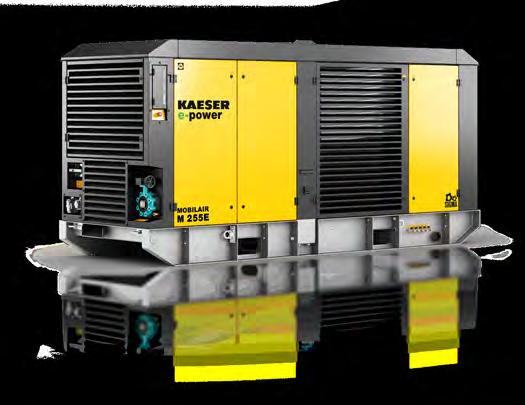
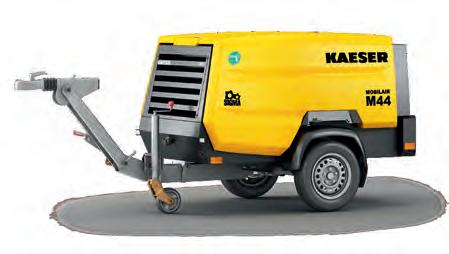
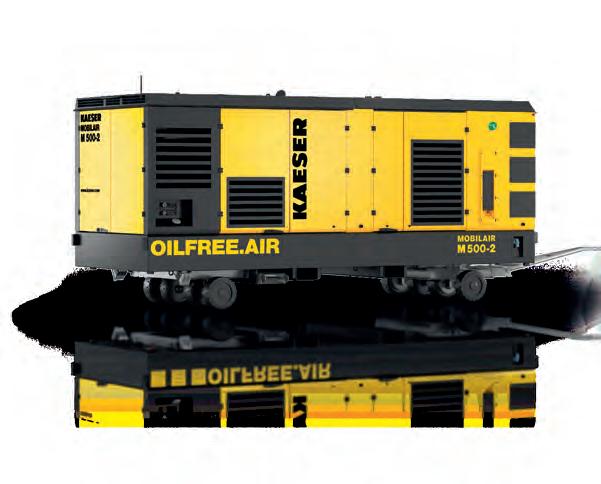
Essential compressed air supply for a furniture and fittings specialist
Design and craftsmanship

Hegewald Holzdesign, a northern German interior fittings specialist based in Diekholzen, boasts over 100 years of family tradition in cabinet making. Now in its fourth generation of leadership, with five family members actively involved, this master craftsman business is celebrated for its exceptional design, functionality, and product quality. A team of skilled experts, each bringing specialised knowledge of various furniture solutions, ensures flawless, responsibly crafted results.
Hegewald Holzdesign, located in Diekholzen, Germany, specialises in crafting bespoke, high-quality furniture and interior fittings tailored to the unique preferences of its clients. This family-run company employs detailed consultation, meticulous planning, and 3D visualisation during the design phase to meet the precise needs of both private and commercial customers.
The consultation phase ensures a seamless balance between function and form for the customer’s desired product. The company’s highly skilled specialists construct, manufacture and assemble intricate interior fittings for bathrooms, kitchens, bedrooms, dressing rooms and home offices in private residences, as well as for offices, doctors’ surgeries, pharmacies, financial institutions, hotels and care homes in the public and commercial sectors. Every hand-crafted product is built to last and meets the highest
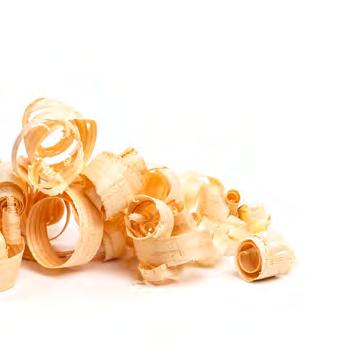
quality standards. Clients receive expert advice regarding suitable materials, optimal use, functionality, and state-of-the-art technology. Additionally, the company places great importance on environmental responsibility, particularly in its use of wood.
Essential compressed air supply
“Compressed air is vital to our workshop,” explains Max Hegewald, great-grandson of the company’s founder, who joined the family business after earning his master’s and design qualifications. “If compressed air is temporarily unavailable, such as during maintenance, nearly all our machines are out of action – except for one or two saws.” Compressed air powers a wide range of the workshop’s equipment, including in the paint shop, where high-quality MDF boards (medium-density fibreboards) are primed. This process protects the boards from environmental factors such as moisture and smooths out any irregularities in the raw material. Using compressed air to atomise the paint ensures that the MDF surfaces
are clean, uniform, and smooth.
Moreover, the wide belt sander cannot operate without a supply of dry, clean compressed air, which controls the pneumatic valves on the machining surface and ensures that the machining arms move at a precise height and depth. Similarly, the CNC machine also depends on compressed air to actuate its pneumatic valves.
Compact machine with large impact
As part of the company’s proven approach, extensive consultations took place prior to the purchase of a new compressor from KAESER in March 2023. The requirements included high availability, energy efficiency, and exceptionally clean compressed air to prevent damage to the sensitive woodprocessing machinery caused by oil, water, or other contaminants. The chosen solution was a KAESER SK 25 rotary screw compressor, delivering a flow rate of 1.71 to 2.69 m³/min and a pressure of 6 to 13 bar. Rotary screw compressors are renowned for their cost efficiency and reliability, thanks to the optimised airend featuring KAESER’s energy-saving SIGMA PROFILE. Addi-
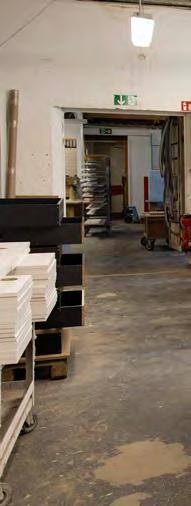
26TH – 30TH MAY 2025
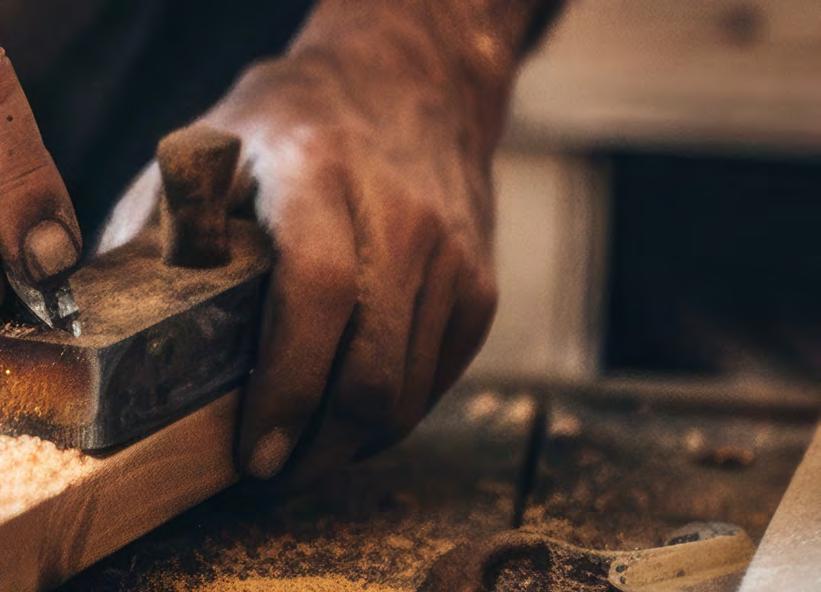
Where to find us:
tional features include Premium Efficiency IE3 motors, the advanced SIGMA CONTROL 2 controller, and a sophisticated cooling system with a dual-flow fan for highly efficient per formance. Compressed air treatment is handled by the compact and reliable KRYOSEC TBH 16 refrigeration dryer, ensuring dependable drying even at ambient temperatures of up to +50 °C. The heat exchanger system’s minimal pressure drop and low-maintenance design contribute to cost-effective operation, whilst the dryer’s compact footprint means that the unit can be installed virtually anywhere. Furthermore, KAESER guarantees long-term supply security by utilising the environmentally friendly R-513A refrigerant.
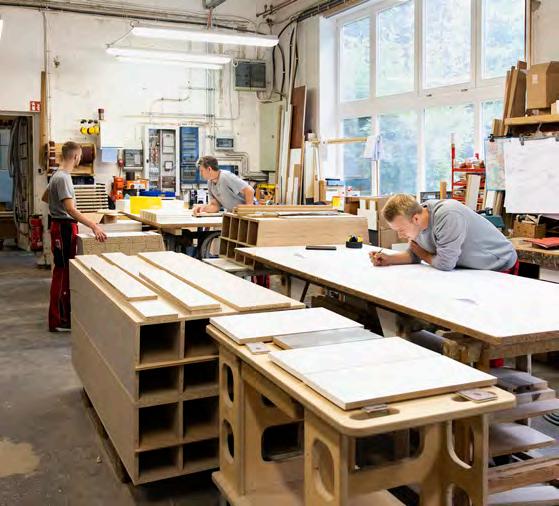
essential for various processing machines at this master craftsman busi-
The compressed air generated by the rotary screw compressor is delivered into a 500-litre air receiver, from where it can be supplied as needed to the consumer equipment. Max Hegewald is highly satisfied with the purchase from KAESER, which guarantees a reliable and cost-efficient compressed air supply for the company for many years to come.
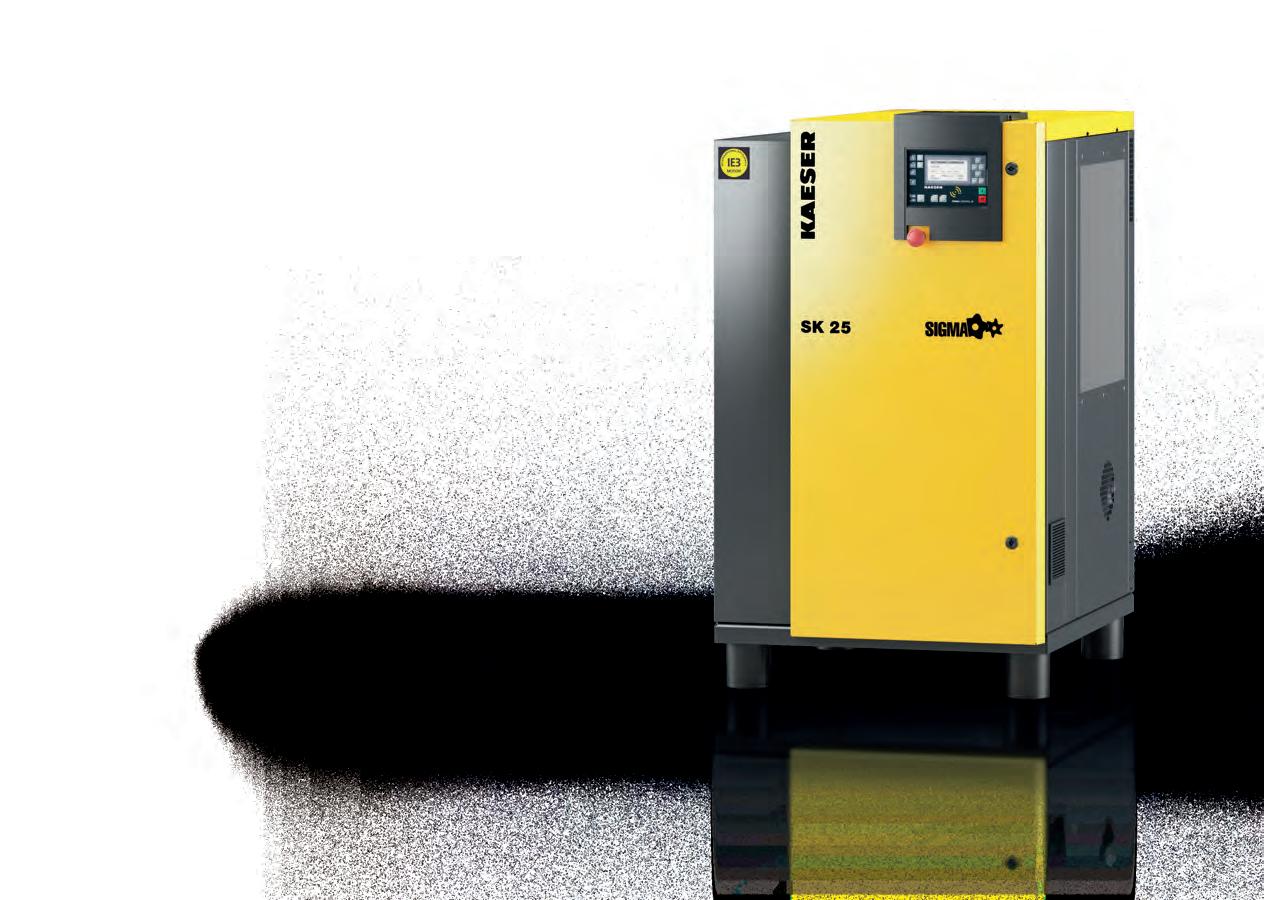
Our wood-processing machines would come to a complete standstill if the compressed air supply were to fail.
Max Hegewald, Master Joiner

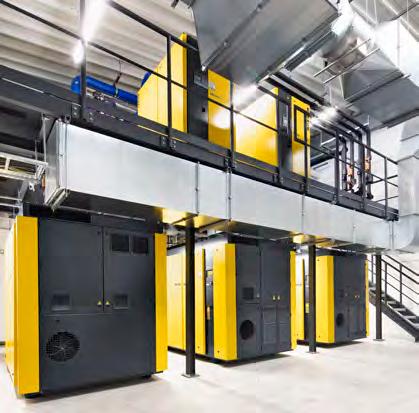
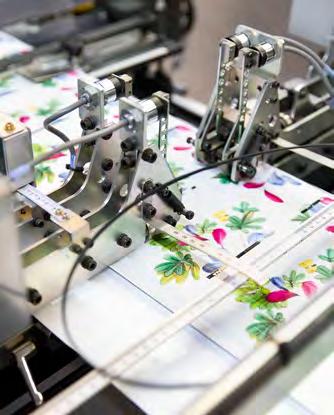
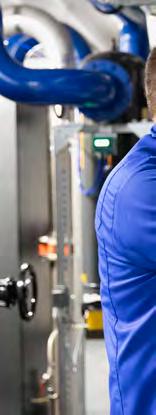
Sustainability in focus
Founded in 1892, Bischof+Klein has grown into a globally sought-after partner for sustainable product protection solutions. As one of Europe’s leading providers of flexible packaging and technical films fabricated from plastic and composite materials, this family business manages the entire value chain, always maintaining a sharp focus on its objective of proactively and sustainably developing product protection systems for its customers.
Bischof+Klein supplies industrial packaging to customers worldwide, including major corporations in the chemical, agricultural, construction, and food industries. In the consumer sector, the company offers premium packaging solutions for renowned brands across agriculture, horticulture, household goods, hygiene, gourmet food, pet food, and cleaning products. The Specials market segment provides major customers worldwide with sur face protection films, heat-activated adhesive films, and specialised com posite films. Bischof+Klein is among the few manufacturers capable of producing cleanroom packaging that meets the ISO Class 5 s tandard. Its CleanFlex® films, designed for ultra-clean products, have seen particularly strong growth. Bischof+Klein em ploys approximately 2,700 people across five production sites in Germany, France, the UK, and Poland. CEO Dr Tobias Lührig explains, “At Bischof+Klein, we embrace a holistic strategy. As a family-owned business, sustainability is deeply ingrained in our values, and we act responsibly from economic, environmental, and social perspectives. Our goal is to create lasting value for future generations—what we call ‘grandchild-friendly’ sustainability. It’s a commitment we uphold every single day.”
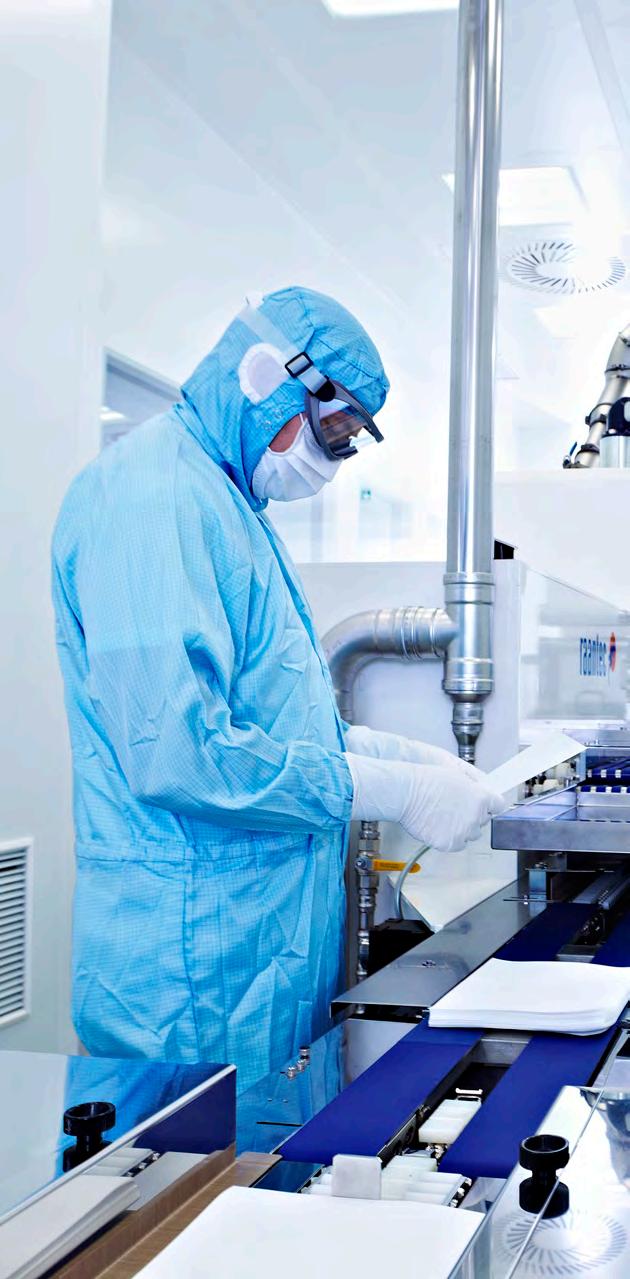

4.0
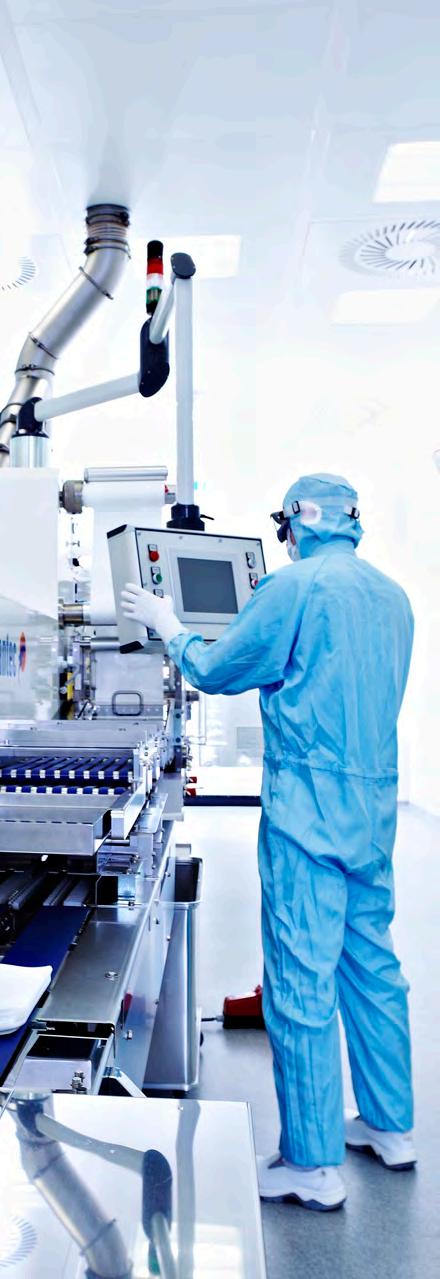
We are extremely pleased with the dependable performance of the two compressed air stations and the significant energy savings they deliver through heat recovery.
André Engel, Group Leader for Building Services Engineering
Sustainable packaging solutions
André Engel, Group Leader for Building Services Engineering, oversees the compressed air supply at the company’s Lengerich site. Highlighting the critical role this versatile energy source plays in their production processes, he explains: “Compressed air is absolutely essential to our manufacturing operations. It’s used at every stage of production across the entire value chain—even for our fire protection system. Essentially, every pneumatic cylinder and valve in all our manufacturing systems is controlled by compressed air.”
The compressed air supply at the Lengerich site has long been provided by two separate air stations. However, due to the age of the compressors, a decision was made last year to modernise the system. The goal was not only to upgrade to the latest technology but also to minimise costly idle times by incorporating frequency-controlled compressors. Another priority was optimising the heat recovery system. As André Engel explains, “With the previous station, we had already established the principle of using our energy input twice through heat recovery. Now, we wanted to take this concept further by modifying both air stations to allow the recovered heat to be used directly where it’s needed.”
Heat recovery serves two purposes: it provides heating for the buildings and supports production processes in the cleanroom, which require precise control of air humidity and temperature. With this specific modernisation objective in mind, and a compressed air demand of 6.2 bar pressure at a flow r ate of 50–70 m³/min, two separate but identical compressed air stations were installed last year, each providing 100% redundancy. Each system includes a DSD 205 and two frequency-controlled DSD 240 SFC rotary screw compressors. To ensure
reliable compressed air treatment, both stations are equipped with two SECOTEC TG 650 energy-saving refrigeration dryers, multiple filters, and an AQUAMAT CF 75 oil-water separator. A SIGMA AIR MANAGER 4.0 master controller is integrated into the process control system, enabling demand-driven compressed air management. This ensures optimal loading of individual compressors and highly efficient control of all system components, significantly reducing idle times and achieving even greater cost savings. The goal of minimising idle times with this modern air station has been successfully accomplished. Previously, idle times s tood at 33.7%, but this figure has now dropped to just 0.19%. The specific pac kage in put power has also improved, decreasing from 6 kW/m³/min to 5.2 kW/m³/min. Last but not least, optimised and localised heat recovery has resulted in significant ener gy savings. André Engel is highly satisfied that all his objectives have been fully achieved.
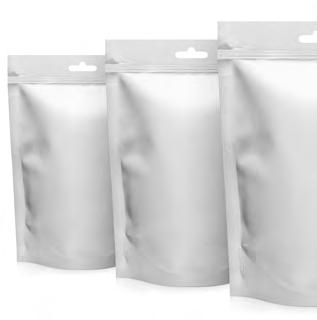
The Great Bubble Barrier® removes plastic waste from rivers and canals
Compressed air bubbles
The idea is as simple as it is brilliant. By placing a perforated pipe at the bottom of rivers and canals and pumping compressed air through it, a rising “bubble wall” pushes plastic waste to the surface, where it can be easily collected. KAESER’s energyefficient rotary screw compressors play a crucial role in this process. Moreover, the powerful compressed air bubble barrier does not disturb aquatic life or shipping.
So how did this idea originate? Three friends and passionate sailors – Saskia Studer, Francis Zoet, and Anne Marieke Eveleens – were frustrated by the amount of plastic waste they found themselves encountering on their sailing trips. While researching the issue, they discovered that 1.8 million tonnes of waste are generated each year, with 80 percent of it entering our seas and oceans through rivers and canals. They realised that tackling these “plastic highways” could significantly address the problem. But the question remained: how?
One day, while enjoying a cold beer together, they observed the bubbles rising in their glasses and wondered if air bubbles could also entrain something in a liquid and carry it to the surface. That day, an idea was born. Together with Philip Ehrhorn, they founded The Great Bubble Barrier® startup.

In our search for a suitable partner, we placed great emphasis on sustainability and energy efficiency.
Erwin Schuitemaker, Project Engineer
Green challenge
At company headquarters next door to the Maritime Museum in Amsterdam, project engineer Erwin Schuitemaker explains how the project began and how winning the “Green Challenge” in the Netherlands’ Postcode Lottery accelerated its development. “After conducting preliminary tests at the water laboratory Deltares, we built a 10-metre prototype in 2017. We also tested it at a wastewater treatment plant in Wervershoof to study the effectiveness of the bubble barrier concept. Later that year, we conducted a successful 180-metre pilot project in the river IJssel, a Dutch distributary of the river Rhine. In 2018, we won the Postcode Lottery’s “Green Challenge”, one of the world’s largest competitions in sustainable entrepreneurship. We were chosen as the winner by an expert jury from over 800 entries. The prize included funding and a six-month expert coaching programme to accelerate the development of our product and company. In November 2019, the first permanent bubble barrier was ready for use in one of Amsterdam’s many canals. This was followed by projects in Katwijk (Netherlands), on the River Ave near Vila do Conde in Portugal, and the latest project in
for cleaner waters
Harlingen (Netherlands), making the Wadden Sea, a UNESCO-protected area, much cleaner. Naturally, we have also grown significantly as an organisation, and our team now comprises 17 employees, including trainees.”
Combating pollution at the source
“With the bubble barrier, we can capture 86 percent of floating waste,” explains Er win Schuitemaker. “The pipe is placed diagonally in a canal or river, where rising air bubbles carry the waste to the surface. The angled arrangement and the natural flow of the water bring the plastic to the edge of the water, where it is then collected and removed. In just one canal in Amsterdam alone, we remove more than 80 kilos of waste from the water each month, consisting of approximately 15,500 pieces of debris ranging in size from 1 mm to 1 metre. In 2020, the “Plastic Soup Foundation” and a team of volunteers began analysing the waste collected by our Bubble Barrier Amsterdam®.” Research is also being conducted in Harlingen by Wageningen University & Research. “By knowing which types of waste are most common and where they come from,” he continues, “we can ultimately tackle the problem at its source by discussing alternatives with the manufacturers and users of these products.”
Leading role for KAESER
“Compressed air is a crucial component of our work. When selecting a compressor supplier, we sought a partner that prioritises sustainability and energy efficiency,” emphasises Erwin Schuitemaker. “We also needed compressors capable of withstanding the challenging conditions in the field. In all of our projects, including those in Portugal, KAESER rotary screw compressors provide a powerful bubble barrier day in, day out, helping us to remove a significant amount of plastic waste from rivers and canals.”
When asked about future projects, Erwin Schuitemaker responds:our “Our goal is to ultimately rid all rivers and canals in Europe and the rest of the world equally of plastic waste. An additional benefit is that the clean air bubbles can increase oxygen levels in the water, which can improve the ecosystem and prevent the growth of toxic blue-green algae.”
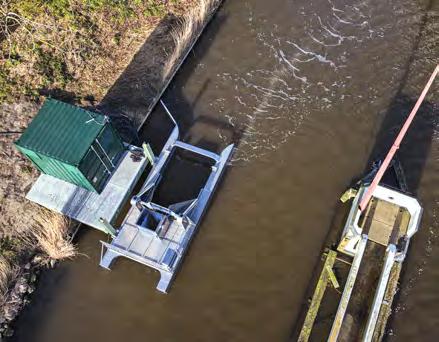
Image above: The bubble barrier and the collection system from above.
Image centre: The goal is to clear canals and rivers of waste.
Image below: Installation of the bubble barrier in Harlingen.
All images: The Great Bubble Barrier and Zeevonk
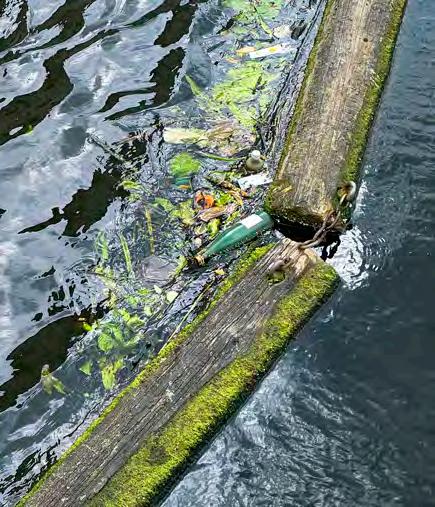
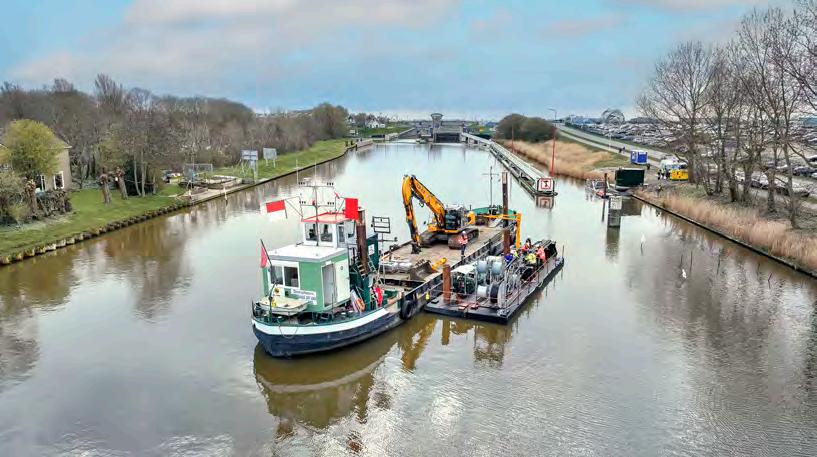

Pockets of delight
Compressed air station requirements: resilience and energy efficiency
Founded in Feuerbach by Richard Bürger in 1934, specialist pasta manufacturer BÜRGER has been providing high-quality regional and national pasta products for over 90 years. Creativity, hard work, and continuous growth have transformed BÜRGER from a successful regional business to the market leader for Swabian pasta specialities.
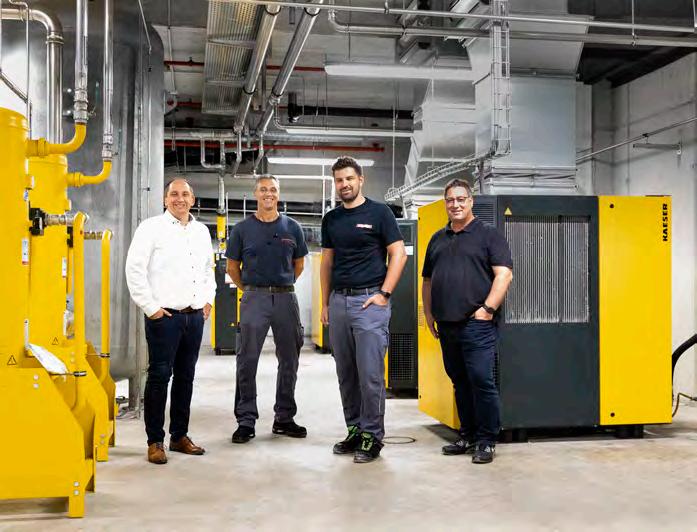
Marcus Härtwig (KAESER), Roland Klein (BÜRGER), Jan Neumeyer (BÜRGER) and Wilfried Leitenberger (Filcom) are proud of the results achieved.
The Italians call them ravioli, whilst in South America they are known as empanadas, and in South Korea mandu. But true Swabian “maultaschen” – pasta squares filled with meat and spinach – originated in Baden-Württemberg. Numerous myths and legends tell the tale of how they first arose, but the most plausible account credits the Cistercian monks of the Maulbronn Monastery with their invention. The monks received a large piece of meat during Lent, which they wished to enjoy without causing offence. Therefore, they chopped it up into small pieces and mixed it with herbs and spinach, so as to give the impression of a
meat-free meal. To conceal the meat further, they divided the mixture up into small portions and wrapped them inside a parcel of pasta dough, thereby creating the first Swabian maultaschen. Anyone who has tried themselves to make these knows how much work they involve. Enter BÜRGER, the Swabian pasta specialist that is dedicated to producing an enormous variety of delicious, high-quality pasta products and is a renowned market leader in Germany.
State-of-the-art sustainability and technology
Any committed amateur chefs who want to take on the challenge of making maultaschen in their own kitchen need to mix together flour, eggs and salt to make the pasta, and then fill it with various ingredients such as meat, cream cheese, vegetables or suchlike. In essence, this is exactly what takes place on a larger scale at the company’s Crailsheim factory. The pasta dough is mixed from fresh ingredients, then stirred and rolled out immediately before undergoing further processing on the production line: the filling is added, covered with another layer of dough, before the full ensemble is cut into its final shape. Finally, the respective speciality is either precooked in giant steamers or deep-frozen.
Unlike in the amateur chef’s kitchen, however, at Crailsheim the process relies heavily on compressed air. Countless valves and cylinders across the 25 production lines are controlled by this energy source, as are the robot grippers. “Without compressed air, our production lines couldn’t function,” explains Jan Neumeyer, the company’s Technical Manager.
The compressed air station has undergone continuous expansion and modernisation in recent years to meet the ever-increasing compressed air demand resulting from the steady increase in production. This has in-
cluded replacement of older compressors in favour of more advanced systems. During the planning phase for the recently inaugurated on-site logistics centre with adjoin-
the first expansion phase, which included commissioning a DSD 240 rotary screw compressor in 2020, projected energy savings of nearly 122,000 kWh, whilst the
At our factory, compressed air supply resilience and dependability is essential.
Jan Neumeyer, Technical Manager
ing refrigeration centre (12,000-m2 storage area with capacity for over 16,000 pallets), it was necessary to consider the compressed air supply once again. The focus was on resilience, dependability, and energy efficiency. The initial step involved a KESS (KAESER Energy Saving System) analysis to assess the current compressed air demand and its associated costs. This enabled Kaeser’s specialists to conduct detailed calculations and simulations to identify which new equipment would optimise the existing system. The goal was to ensure that future compressed air requirements would be met with maximum reliability, energy efficiency, and cost effectiveness. The simulation for
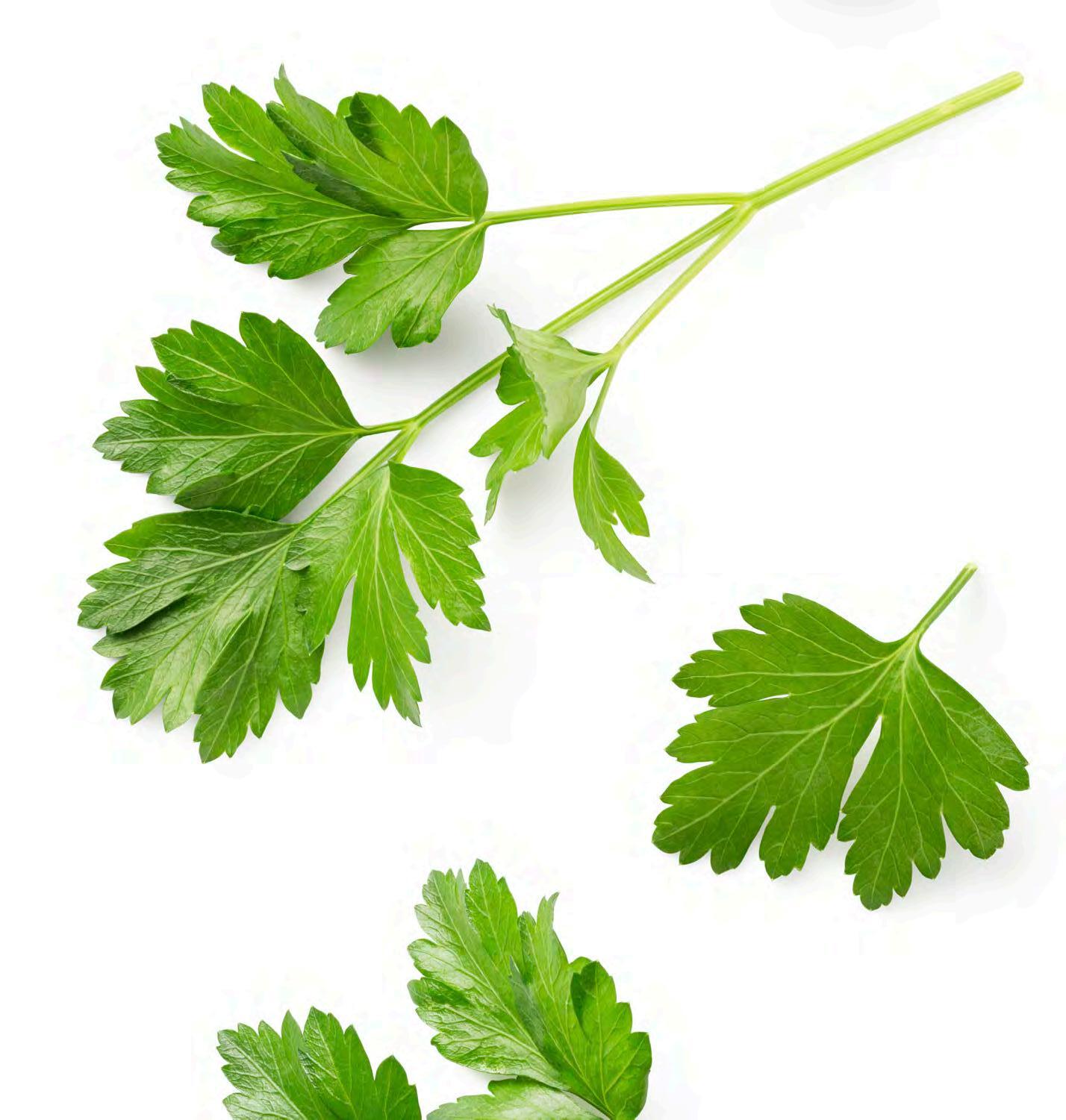
simulation for the second phase, planned for 2024 and involving the addition of a frequency-controlled CSDX 175 SFC, resulted in an additional projected energy saving of approximately 50,000 kWh.
The new compressors were seamlessly incorporated into the existing system and have fully met the company’s expectations for energy efficiency and reliability. Today, the Crailsheim facility features multiple compressed air stations, delivering air on demand to various areas of the factory. At Plant 1, five KAESER rotary screw compressors with a combined output of 500 kW supply the necessary compressed air.
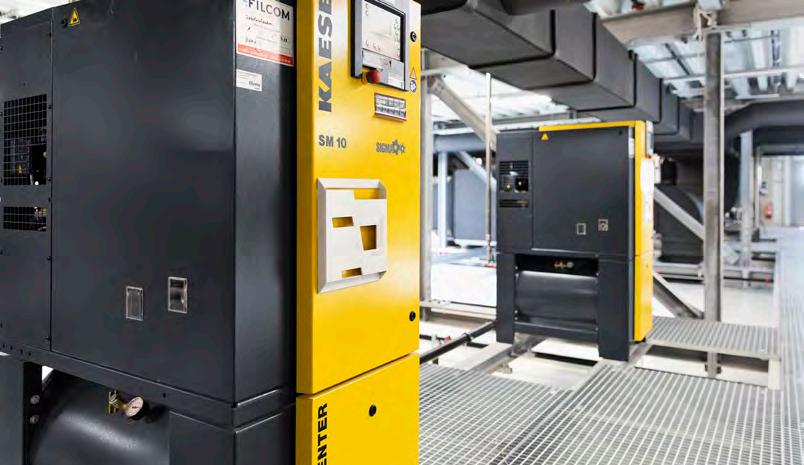
Meanwhile, Plant 2 is equipped with six rotary screw compressors delivering a total output of 250 kW. Additionally, two AIRCENTER models have been installed to support the new logistics centre. The compressed air stations in Plants 1 and 2 are managed and monitored by a master controller (SIGMA AIR MANAGER 4.0).
To meet the strict quality standards required for BÜRGER products, both plants are also equipped with two energy-efficient KAESER refrigeration dr yers, together with multiple KAESER Filters and activated carbon adsorbers. This setup ensures reliable compressed air treatment that complies with purity class 1:4:1 according to ISO 8573-1:2010.

Precision high-pressure specialists
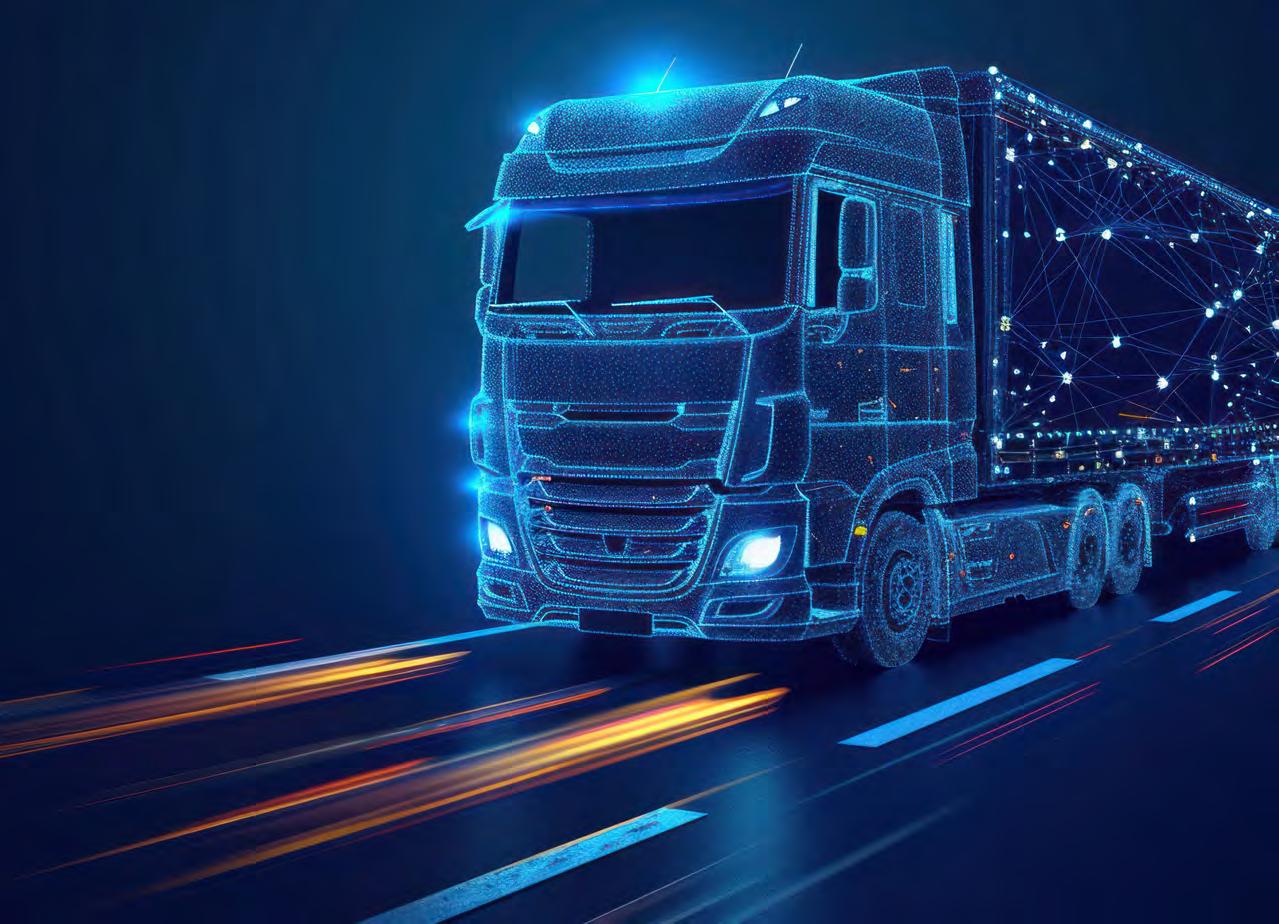
A visit to one of the world’s largest commercial vehicle manufacturers
Special applications often call for special solutions. While most industries and processes typically require control and process air within a pressure range of 5 to 8 bar, certain operations demand higher-pressure compressed air at specific points. For these scenarios, KAESER booster systems provide the perfect solu tion, offering outstanding efficiency, flexibility, and minimal maintenance requirements.
The production hall of one of Germany’s largest commercial vehicle manufacturers is vast, matching the scale of the vehicles it produces. Each vehicle model has its own dedicated assembly line, with assembly stations spread across multiple production levels. A fully automated, dr iverless tr ansport system efficiently moves parts between these stations. An essential factor in ensuring the longevity of commercial vehicles is effective corrosion protection for the cab. A multi-stage paint process not only delivers a g leaming finish but also provides robust, long-term corrosion resistance. Once the bodywork has been painted, the customised interior is installed, including seats, beds, cockpit and interior trim.
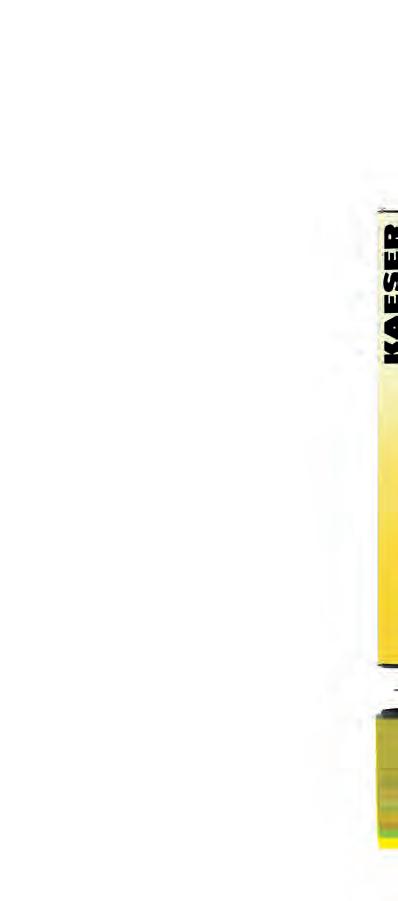
The vehicle chassis is constructed in the chassis assembly area. Following installation of the pneumatic and electrical systems, the suspension and axles are added to the chassis frame, and then the underbody paint is applied. Subsequently, vehicle assembly continues with the installation of major components such as the engine and cab. Throughout the assembly process, each vehicle undergoes rigorous testing and inspection at various stages, before being delivered to the customer following successful final acceptance.
Boosters provide the required pressure
As with many industrial operations, the

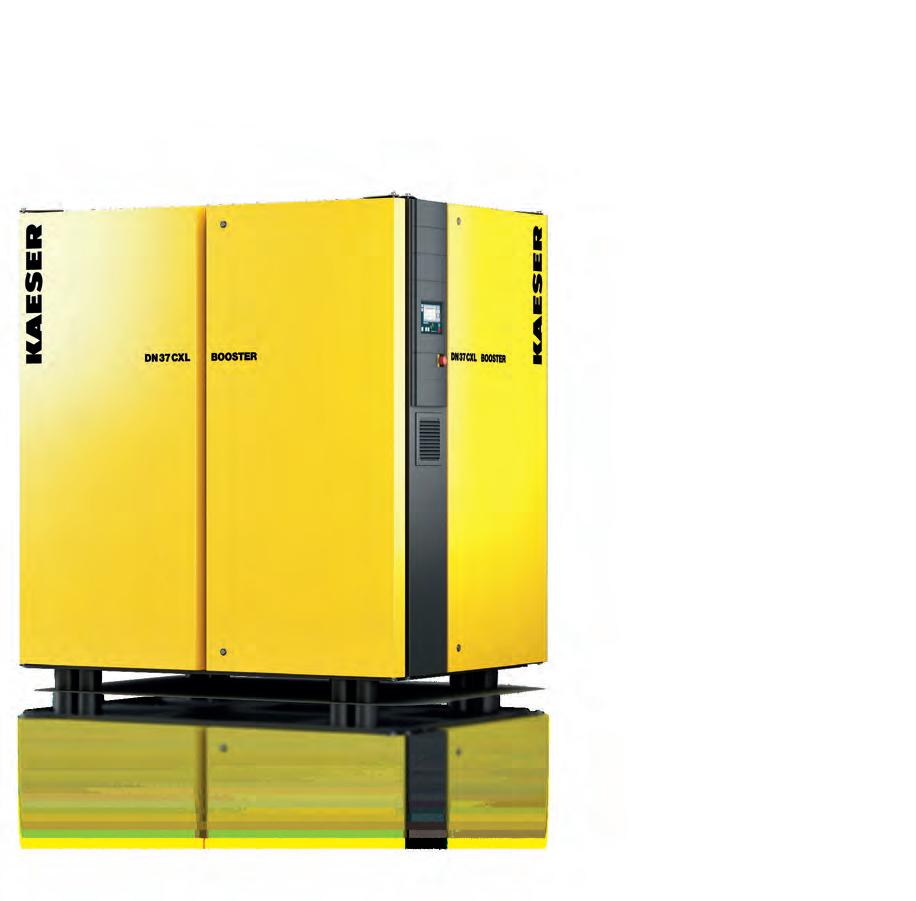
majority of compressed air consumers in commercial vehicle manufacturing require a system pressure of around 6 bar for applications such as control and work air, screwdrivers, and pneumatic door openings. However, for a considerable proportion of the total air volume, a much higher system pressure is required – typically around 20 bar. One such application is the tyre inflation system. To save time, the gig antic tyres are not inflated using a valve, but by directly introducing air between the rim and the tyre, a profor high pressure just to accommodate a specific points of use,” explains Oliver er, Sales Manager for KAESER Germany. KAESER of fers a finely tuned ange of high-performance booster reciprocating compressors, each tailored to provide the ideal solution for a multitude of applications. For commercial vehicle manufacturers requiring compressed air up to 25 bar, the DN 37 C XL is the perfect choice. This model delivers the highpossible flow r ate (initial pressure: bar, final pressure: 1-45 bar, flow ate: 2.26-19.60 m³/min). The newly redesigned system boasts improved cooling air management and enhanced accessibility for maintenance and servicing. The upgraded SIGMA CONTROL 2 controller offers advanced monitoring and control capabilities, featuring multiple interfaces for seamless integration with master control systems – complete with dynamic control. Moreover, the IE4 motors installed in N-series boos ters deliver outs tanding efficiency, reducing energy consumption and production cos ts while also significantly ibuting to climate protection.
When higher pressure is needed at specific points, it is far more cost-effective to “boost” the existing network pressure in a precise and targeted manner.
Oliver Pschirrer, Sales Manager KAESER Germany
Compressed air station keeps pace with production growth
REVOLUTIONISING THE PACKAGING INDUSTRY
LINHARDT Group GmbH is one of the leading manufacturers of aluminium and plastic packaging in Europe, and a global market leader in the production of aluminium tubes for the pharmaceuticals industry. The company has remained family-owned since its founding 80 years ago, and values such as continuity and dependability remain a fundamental part of its identity. LINHARDT is a valued partner for a multitude of satisfied customers around the world, from global corporations to smaller, mid-sized companies – a true “hidden champion”.
Virtually every one of us has a product from LINHARDT in our home. This globally active specialist with its headquarters in Viechtach, Lower Bavaria, produces packaging used for everyday items which are healthy, ornamental, perishable, or valuable. 80 years after its establishment, the profitable mid-sized company remains in the hands of its founding family. Providing employment for around 1,750 people worldwide, its factories design, manufacture and distribute high-quality aluminium and plastic packaging, tooling, and format parts that meet the highest GMP quality requirements.
LINHARDT develops and manufactures a range of aluminium and
plastic tubes, aerosol cans and other aluminium and plastic packaging solutions at three sites in Germany and four in India. Its portfolio can be divided into four product groups: Healthcare (pharmaceuticals packaging, such as aluminium tubes or tablet tubes), Beauty (cosmetics), Home (food products, industrial and technical products, as well as pens manufactured from aluminium tubes), and Time Out (bottles for spirits and energy drinks, cigar tubes). A number of the company’s products are patent-protected, such as a 9.8-mm tube for eye ointment, the development and manufacture of which requires specialist know-how.

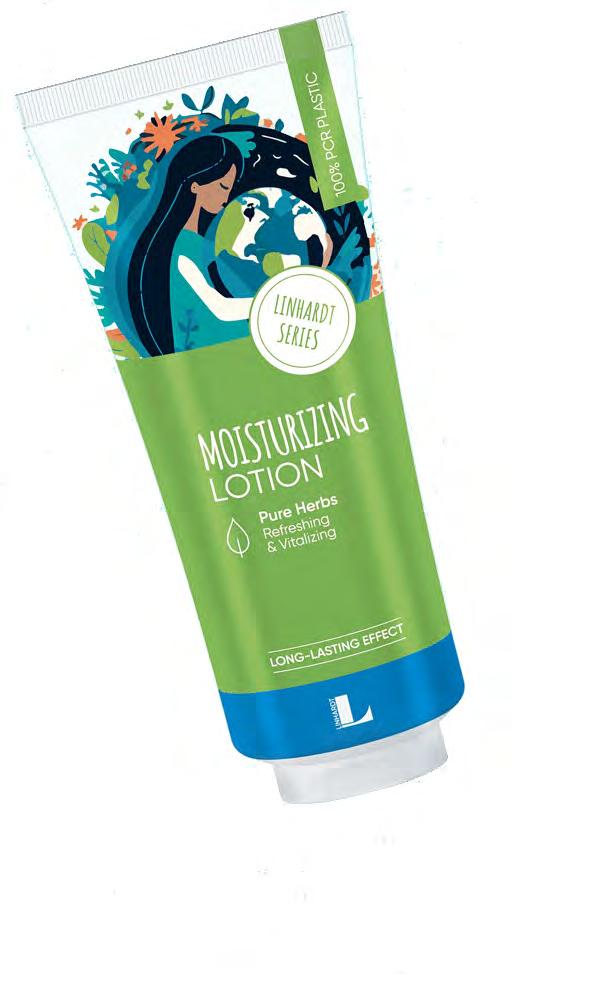
Digitalisation and automation are firmly anchored in all of LINHARDT’s production, logistics and planning processes. Sustainability and the circular economy are key considerations from the very beginning of the product development process. Material reduction and recyclability are considered and post-consumer recycled content is used, for both aluminium and plastic packaging solutions. In recent years, LINHARDT has received multiple prizes for its sustainable product solutions, including the World Star Award and the German Packaging Award, most recently in 2024 for its “Next Gen PCR plastic tube”, the first plastic tube featuring 100% post-consumer recycled materials, including the cap.
Heat recovery achieve significant by heating our 88°C at no
Stefan Ernst, Deputy Director

Success need space
The company’s success curve has ascended ever more steeply in the past few years, leading to a continuous increase in production space. In 2020, a new factory was purchased in neighbouring Linden, which now houses the TEC.POINT tools division. In addition, a new construction project at the Viechtach site is soon to be inaugurated, providing room for more production lines. This rapid growth has meant a corresponding expansion of the compressed air supply; each time air demand has reached the capacity limits of the existing system, the old machines have had to be replaced by new
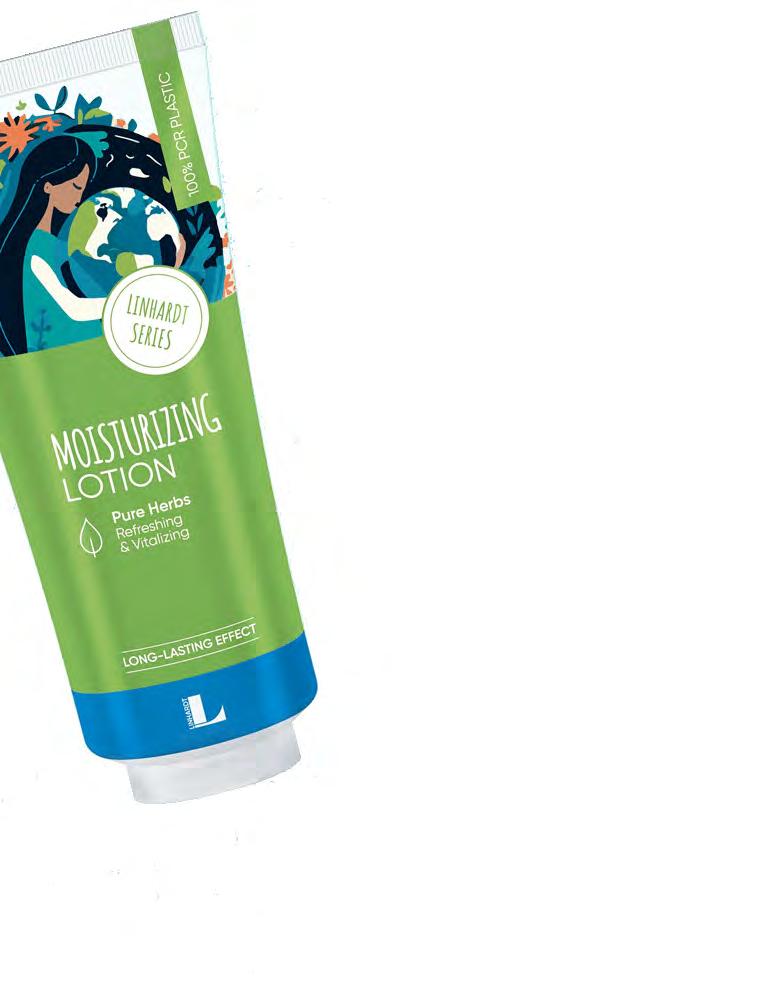
recovery enables us to significant cost savings our production water to no additional expense.
Director Operations and Technical Director
ones with higher performance capability. The compressed air station at Viechtach formerly consisted of compressors from a variety of manufacturers, connected by a controller that was programmed in-house. The latest investment project for the compressed air supply took place in 2023, whereby the
previous compressor with the highest performance was replaced by a KAESER DSDX 305. In addition, the operator sought to benefit from needs-based compressed air management, including optimised maintenance and servicing, complete station monitoring, operating data reporting, and the provision of energy management data. Stefan Ernst, (Deputy Director Operations and Technical Director) and Andreas Schedlbauer (responsible for facilities management and media supply) recall that their introduction of the SIGMA AIR MANAGER 4.0 master controller was one of the key developments of recent years. This has enabled idling times to be reduced significantly, whilst ensuring balanced loading of the compressors and the overall efficiency of the compressed air station.
Equipped for the future
Moreover, all of the compressors at the Viechtach and Linden sites have now been replaced by new, high-performance KAESER compressors, which dependably and efficiently fulfil the requirements of 6.3-bar network pressure at a flow rate of 75 m³/min. The Linden facility operates two BSD 75 SFC rotary screw compressors connected to a SIGMA AIR MANAGER 4.0. At Viechtach is a further SIGMA AIR MANAGER 4.0 which controls and monitors five KAESER rotary screw compressors (DSDX 305 SFC, DSDX 302, DSB 170 SFC, DSDX 245 and DSD 205). Two KAESER air receivers with a capacity of 8,000 litres each ensure an even supply in the event of
fluctuating demand. Downstream from the two receivers are numerous treatment components that ensure consistently high compressed air quality.
In addition to energy efficiency and compressed air quality, the principle of heat recovery is important to Stefan Ernst. The compressors are equipped with internal plate-type heat exchangers, which can be used to extract the exhaust heat from the compression process for heating purposes: “Our production processes require hot water at a temperature of around 88 °C. Heat recovery enables us to achieve significant cost savings by heating our production water at no additional expense and allows us to take an important step toward reducing greenhouse gas emissions and progressing toward future CO2-neutral production.”
Addressing water scarcity with smart irrigation systems
Agriculture is one of the largest and most significant industries globally, accounting for 70 percent of the world’s water consumption for crop irrigation. However, water resources are limited, so innovative solutions are needed to address the challenge of water scarcity.
Since the Neolithic era around 12,000 years ago, when the fir st human groups in the “Fertile Crescent” of the Middle East began practicing agriculture and animal husbandry, humans have sought to tame nature by cultivating food plants from wild grasses. Over time, people developed irrigation systems, with the earliest archaeological evidence of this dating back some 8,000 years to the Jordan Valley. In the following millennia, irrigation techniques spread throughout Persia, the Middle East, and westward along the Mediterranean. In the New World, the Incas, Mayas and Aztecs also used irrigation extensively. Global water consumption has surged dramatically since the dawn of agriculture and continues to rise as the area of cultivated land increases. According to the World Agriculture Report, agriculture today consumes 69 percent of the world’s available fresh water. This figure is projected to rise by 19 percent by 2050. Only through conscious and responsible water management can we meet these growing challenges.
Modern drip irrigation, used in today’s agriculture, is a water- and fertiliser-saving method that slowly delivers water through a network of valves, pipes, hoses and dripping devices, either to the soil surface or directly to the plant’s root zone. With a water use efficiency of 95 to 100 percent, drip irrigation can reduce a farm’s water consumption by up to 60 percent and increase crop yields by up to 90 percent compared to traditional irrigation methods.
More than just a drop in the bucket METZERPLAS Israel is a company specialising in modern drip irrigation systems for both agricultural and private applications. Founded in 1970, this long-established global enterprise is dedicated to developing and manufacturing a wide range
of drip irrigation pipes, PE piping for water, wastewater and gas, as well as frictionreducing connection pipes, using only high-quality ecological materials. Metzer has locations in Israel (headquarters), Ukraine, Kazakhstan, India, Thailand, Mexico, and more.
The company has also been represented in Romania by its subsidiary METZERPLAS EU S.R.L since 2023. Even during planning of the new building in Chitilia (near Bucharest), careful consideration was given to the compressed air supply, as it is essential for the production of drip irrigation pipes and for operating machinery and equipment. Currently, two extrusion lines for HDPE pipes and one extrusion line for PVC pipes are in operation, with compressed air required for both process and control air purposes. Moreover, a special compressed air application is used during quality inspection of the final products, whereby the diameter, thickness of the pipe, and the spacing of the drip outlets are checked by applying a pressure of 1.2 to 1.5 bar to the pipe.
When searching for a suitable compressed air system provider, energy efficiency was a primary focus. KAESER stood out with its principle of providing “More compressed air for less energy”, a philosophy which is core to its entire product range. The offer was tailored to the specific requirements provided by METZERPLAS Romania: a minimum pressure of 6.2 bar, a maximum volume of 3.8 m³/min, and purity class 1-42 in accordance with ISO 8573-1. The compressed air in Chitilia is supplied by two KAESER SK22 rotary screw com-

ADVANCING IRRIGATION DROP
ADVANCING IRRIGATION BY DROP

pressors equipped with power-conserving refrigeration dryers. These SK series compressors are highly efficient due to their optimised rotary screw airend with SIGMA PROFILE rotors. The addition of Premium Efficiency motors and a dual-flow fan cooling system further enhances their energy-saving capabilities. Last but not least, the internal SIGMA CONTROL 2 compressor controller provides comprehensive air system management and control.
The compressors perform flawlessly, which is a significant advantage for our company, as we operate in a three-shift system.
Constantin Hada, CEO of METZERPLAS EU SRL
The state-of-the-art compressed air station also features a 1000-litre air receiver, which balances peak consumption and reduces switching frequency, thereby increasing compressor efficiency and service life. To meet the required air quality standards, the system utilises an AQUAMAT CF9 oil-water separator and a KAESER F46KE filter.
Constantin Hada, CEO of METZERPLAS Romania, is very satisfied with the technical per formance of the compressed air station: “Our company operates in a three-shift system, so uninterrupted compressed air supply is crucial. We are exceptionally pleased with the reliability of the compressed air station.”
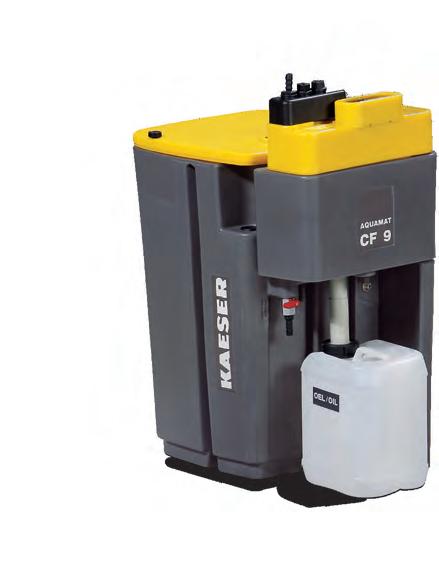
ProRheno AG, established in Basel in 1975, operates as a joint enterprise comprising three key facilities: ARA Basel (municipal wastewater treatment), ARA Chemie Basel (chemical wastewater treatment), and a sludge treatment plant for incinerating accumulated sewage sludge. The municipal plant managed by ARA Basel processes wastewater from the canton of Basel-Stadt (Basel City) and surrounding municipalities, including one French and two German districts. Meanwhile, wastewater from nearby chemical plants is treated separately at the ARA Chemie Basel site. Sludge from both facilities is incinerated at the shared sludge treatment plant, with the resulting slag and ash being deposited in a dedicated slag compartment at the Elbisgraben landfill site.
New technology for new requirements
The ARA Basel treatment plant, designed to serve 520,000 population equivalents, is one of largest such facilities in Switzerland. Covering 76,300 m² in the Basel-Kleinhüningen district, it processes 86,000 cubic metres of wastewater daily, amounting to approximately 30 million cubic metres annually. The recent extensive renovations and new construction were prompted by updates to the Water Protection Ordinance, which introduced stricter requirements for nitrogen removal. Additionally, plans included the installation of a new treatment stage to eliminate microcontaminants, ensuring the plant remains equipped to meet
ARA Basel: Switzerland’s largest wastewater
Seamless transformation
In recent years, the construction activities at the ARA Basel municipal wastewater Switzerland. This extensive undertaking, involving both major renovations and limits introduced under the revised Swiss Water Protection Ordinance of 2023. ment throughout the duration of the project.
future demands. The new compressed air and blower systems installed as part of the project were supplied by KAESER KOMPRESSOREN. With regards to compressed air, the treatment plant requires an 8-bar pressure to operate a wide range of pneumatic valves and slides. For the sand traps, frequency-controlled CBS 121 L SFC rotary screw blowers (7.5 kW) are used, whilst CSD 105 SFC rotary screw compressors, also with frequency control, supply the necessary control air. During the summer, compressed air drying is handled by two energy-efficient SECOTEC TE 102 refrigeration dryers. In winter, to achieve lower pressure dew points and to protect piping from colder temperatures, two DC 75 desiccant dryers are used for this purpose. Operating air for the three sludge incineration ovens is supplied by DSD 202 rotary screw compressors, while compressed air for aerating the process water in the
annamox process comes from CBS 121 L SFC rotary screw blowers. Furthermore, for the sand filtration procedure in the new fourth treatment stage, type BB 69 C rotary lobe blowers (5.5 kW) ensure circulation in the inlet channels, and type FB 621 C (75 kW) machines are used for backwashing of the filter cells.
Blower air for biological treatment
Blower air is essential for aerating the biological wastewater treatment stage, which uses a Sequencing Batch Reactor (SBR) process – a variation of the conventional activated sludge method that relies on suspended sludge. In this process, the activated sludge, consisting primarily of microorganisms, breaks down dissolved pollutants in the wastewater. What makes the SBR process unique is that the treatment steps are conducted sequentially in time rather than in separate physical stages. Biolog-
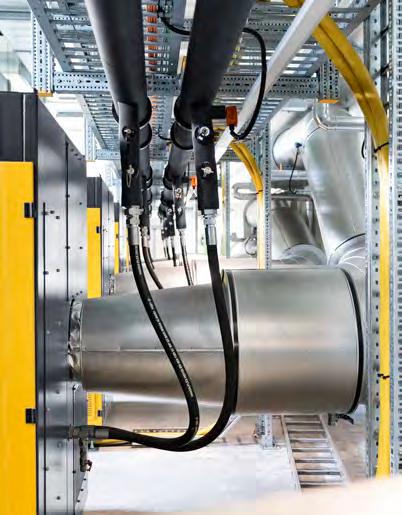

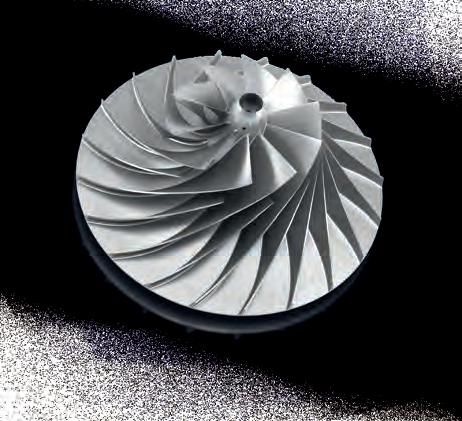
transformation wastewater treatment construction project
wastewater treatment plant represented the largest project of its kind in and new construction, was driven by the updated regulations and stricter 2023. One of the key challenges was to ensure uninterrupted wastewater treat-
ical treatment and sedimentation occur in distinct phases within the same reactor. Incoming wastewater is collected in a buffer tank, treated in batches, and then discharged at the end of each treatment cycle.
During the initial planning phase, Malte Alpers, Operating Engineer at ProRheno AG, carefully considered the technical requirements for aeration: “Our tanks are unusually deep at 8.7 metres, which necessitates substantial air volumes delivered at specific intervals during the aeration cycles. Each cycle spans six hours, with approximately 2.5 hours allocated to the aeration phase. Initially, a very high oxygen supply is needed for about an hour, followed by a shorter period where the air volume is gradually reduced. The frequent starts and stops in this process could pose challenges for both rotary lobe and rotary screw blowers. KAESER tur-
bo blowers, however, are perfectly suited for frequent start-stop operation, thanks to their contact-free magnetic bearings and low mass forces.” This made them the ideal choice for the tank aeration process. Now, up to five SBR reactors can operate simultaneously in the aeration phase, with each reactor supplied by one of six KAESER PillAerator HP 9000 turbo blowers (300 kW). The high-frequency motor is directly connected to the turbo impeller without a transmission, eliminating the need for lubricants and other wear-prone components. As a result, maintenance is solely limited to air filter replacement. This forward-thinking design makes KAESER turbo blowers the perfect solution for demanding applications such as the SBR reactors at ARA Basel.
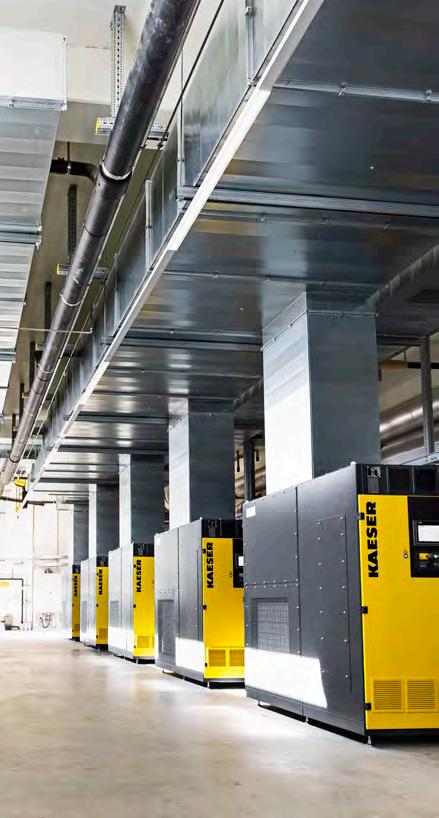
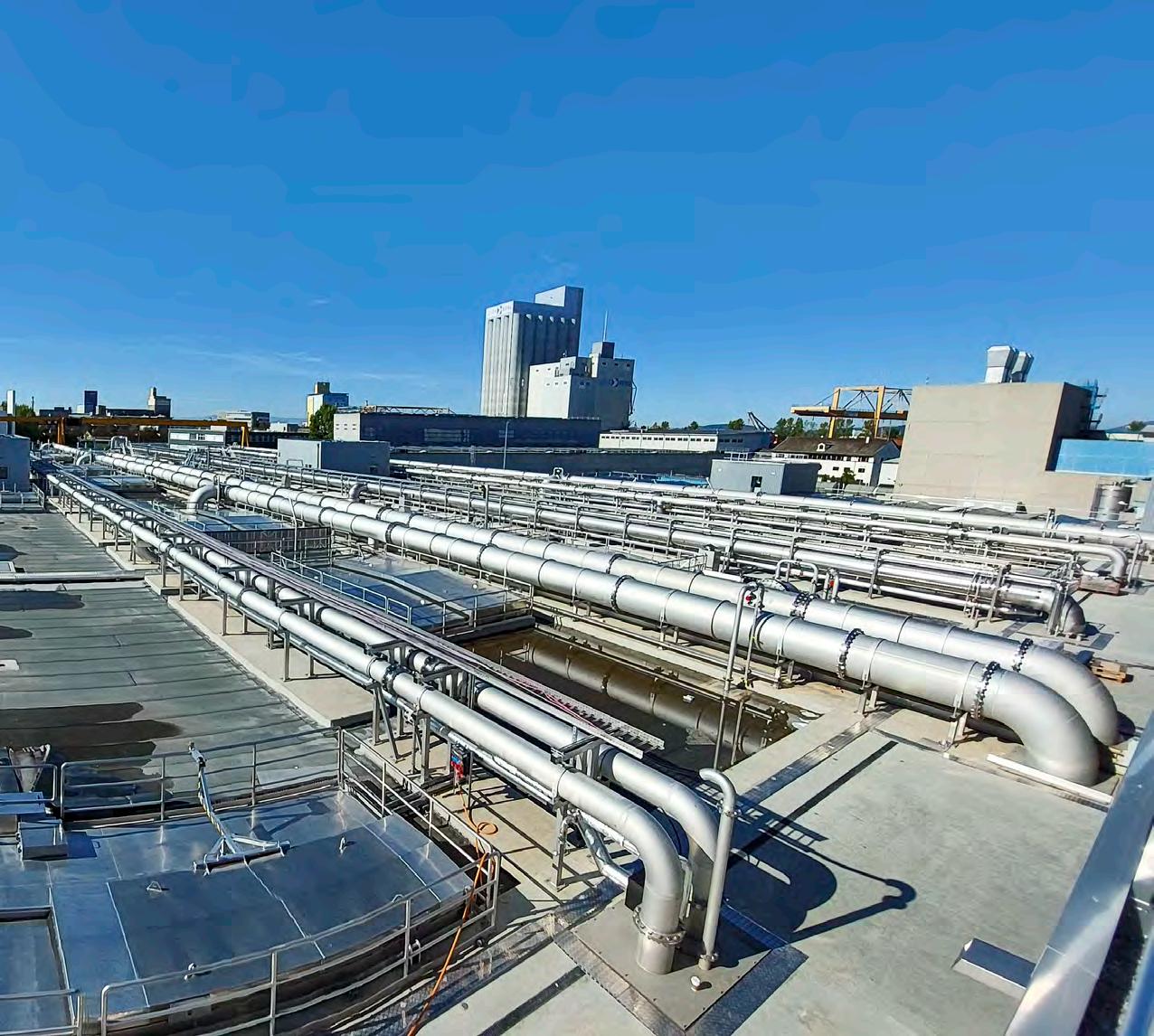
Thanks to their magnetic bearings, the turbo blowers can be switched on and off as often as needed without issues.
Malte Alpers, Operating Engineer
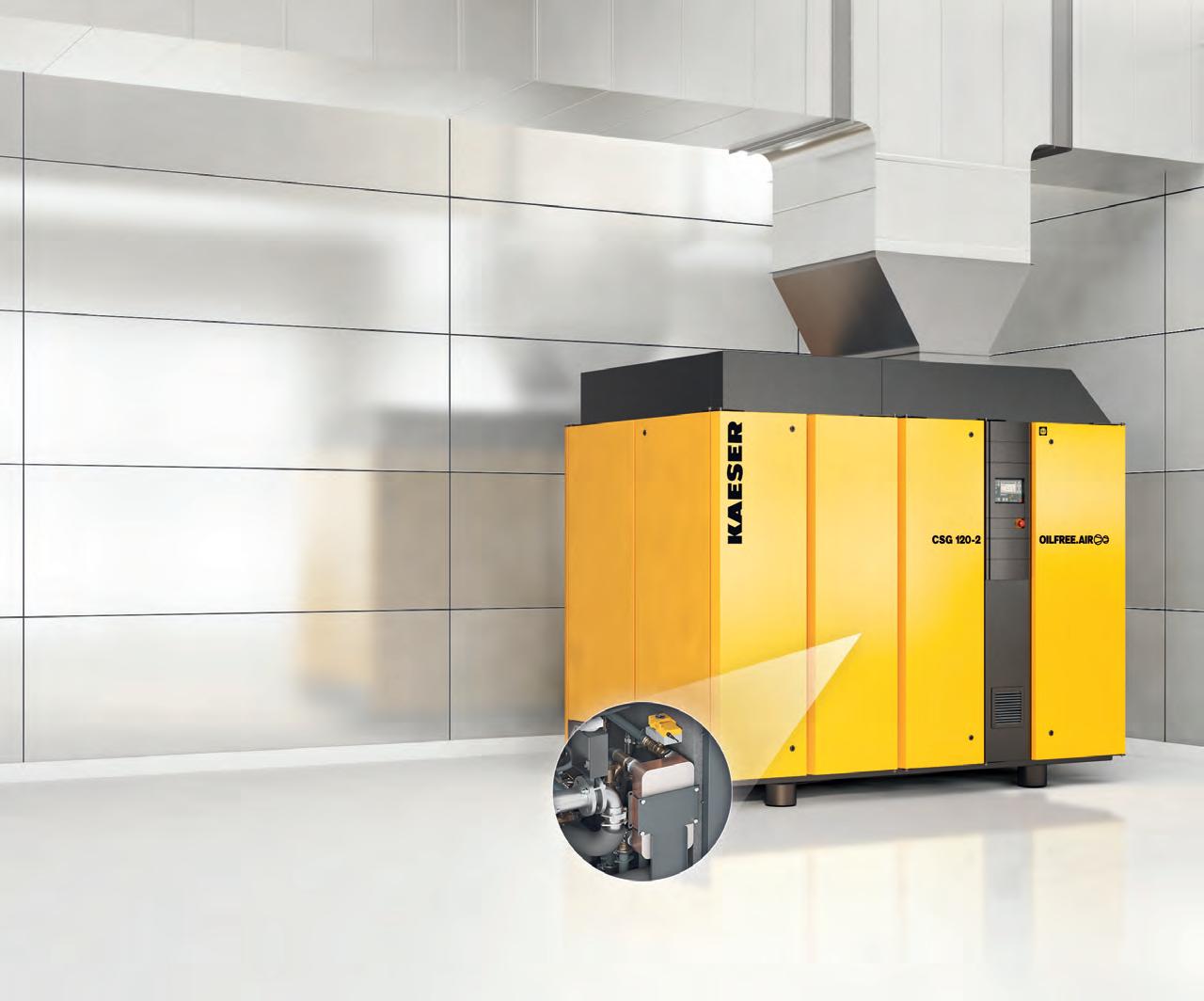
Sustainability in action
HEAT RECOVERY
The right choice – Save energy, sustainably
• Energy-efficient – Utilise compressor exhaust heat for heating spaces, supplementing heating systems, or warming process water
• Sus tainable – Unlock significant potential for reducing CO₂ emissions
• Tailored to your needs – Customisable inlet and outlet water temperatures to suit individual requirements
• Flexible – Available as a factory-installed option or as a retrofit for existing systems
• Funding opportunities – Government subsidy programmes for energy-efficient initiatives
Up to 90% heat recovery potential
